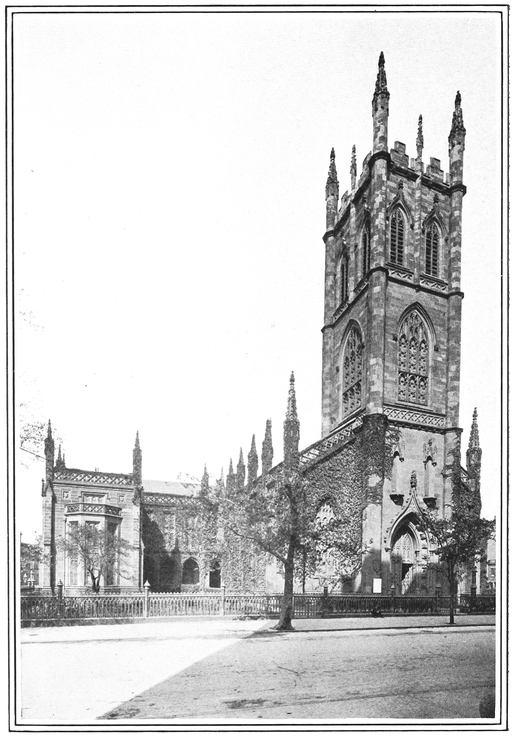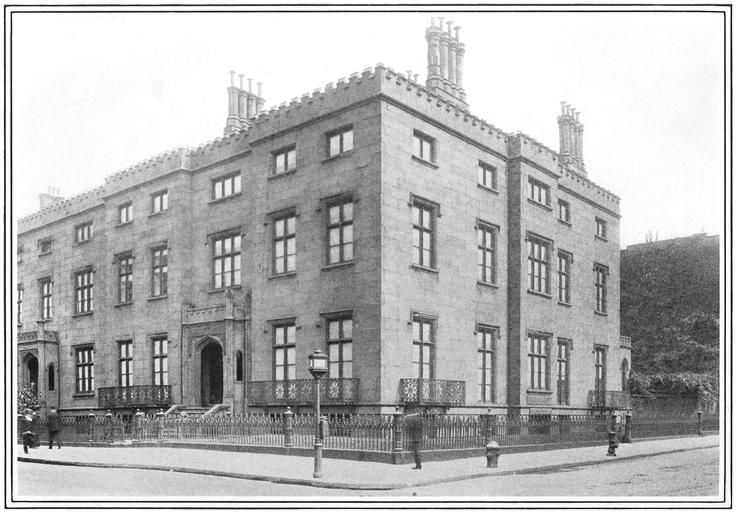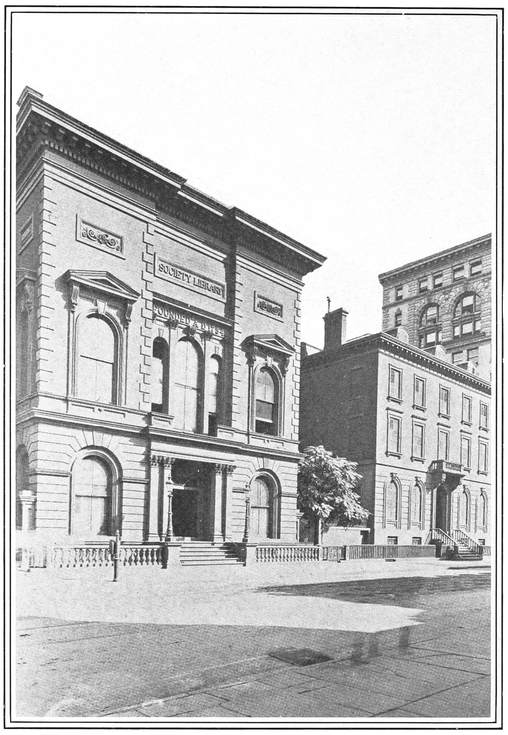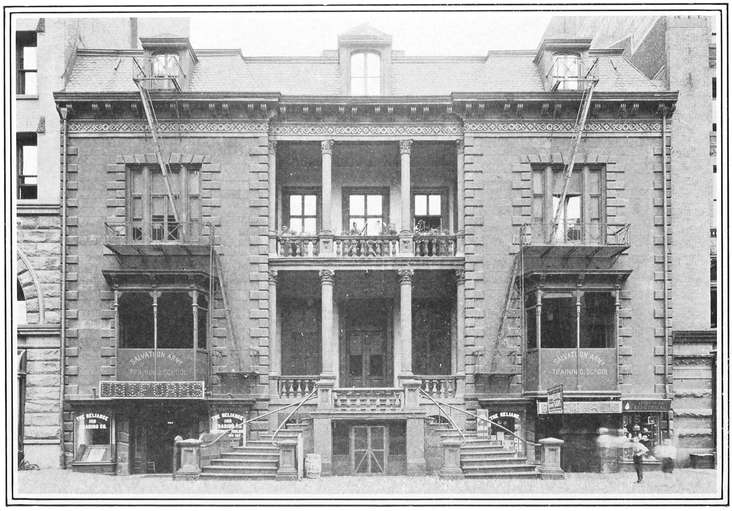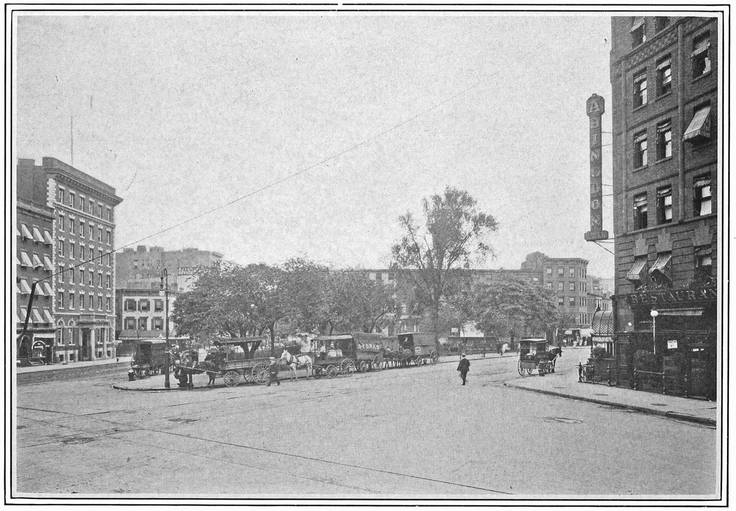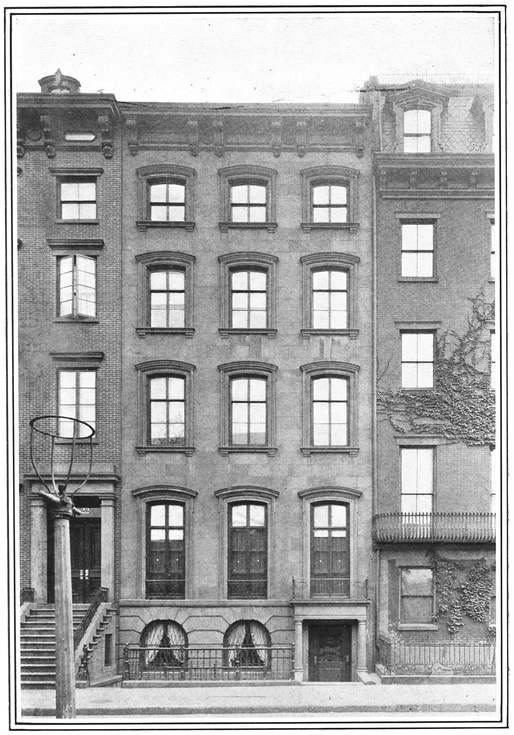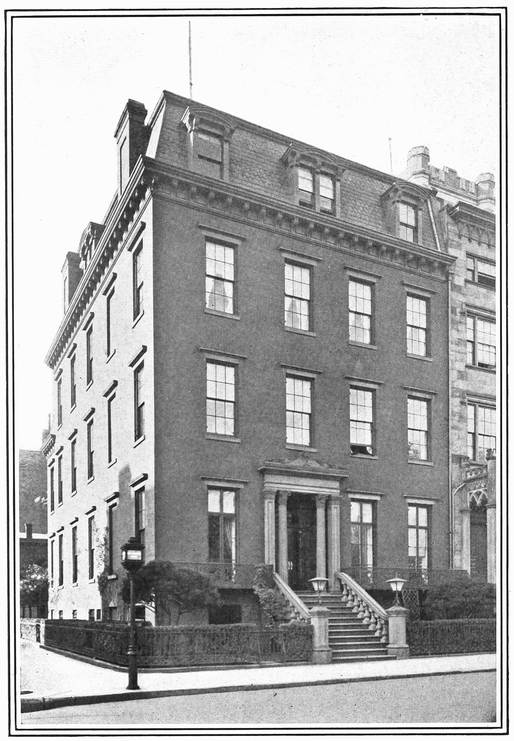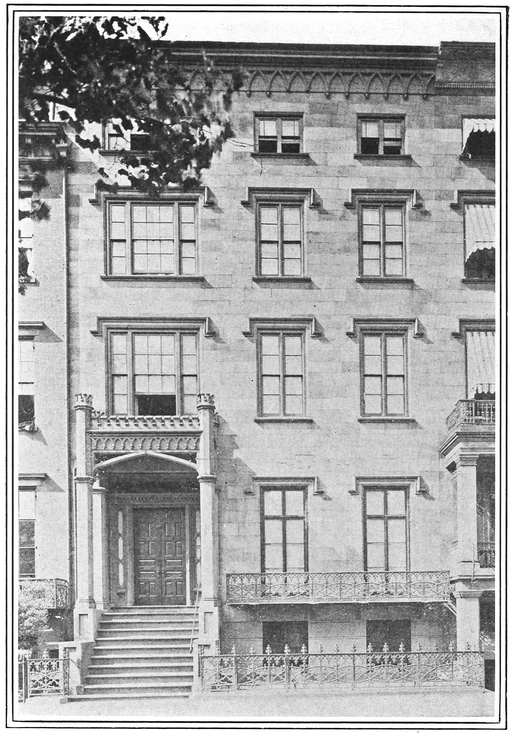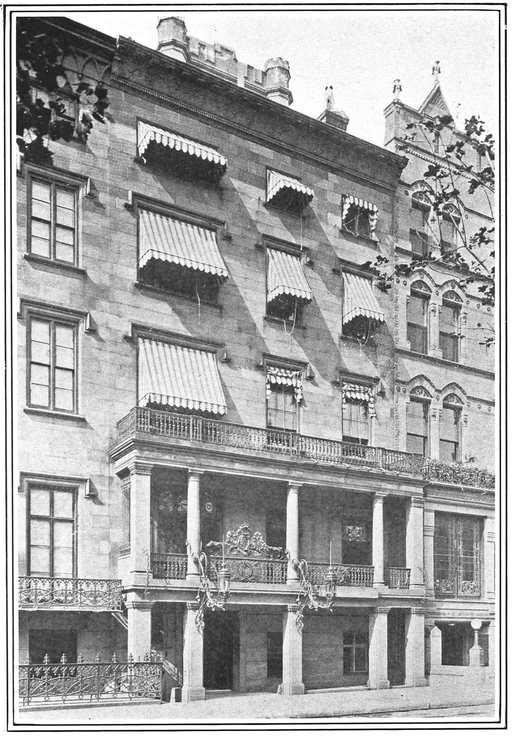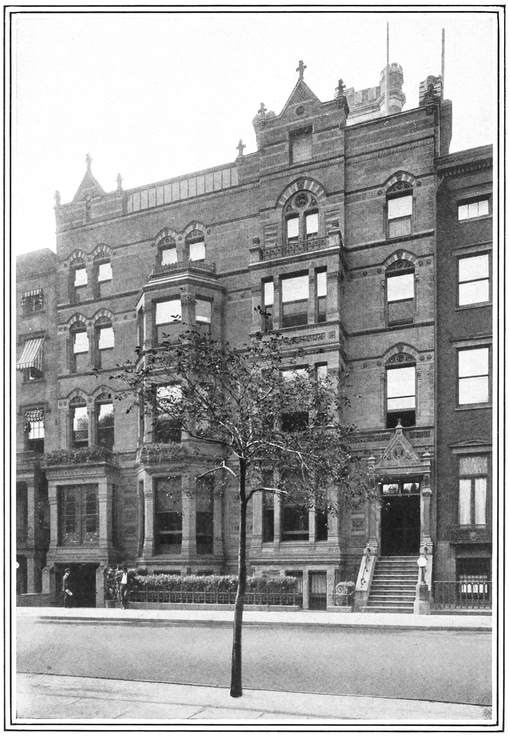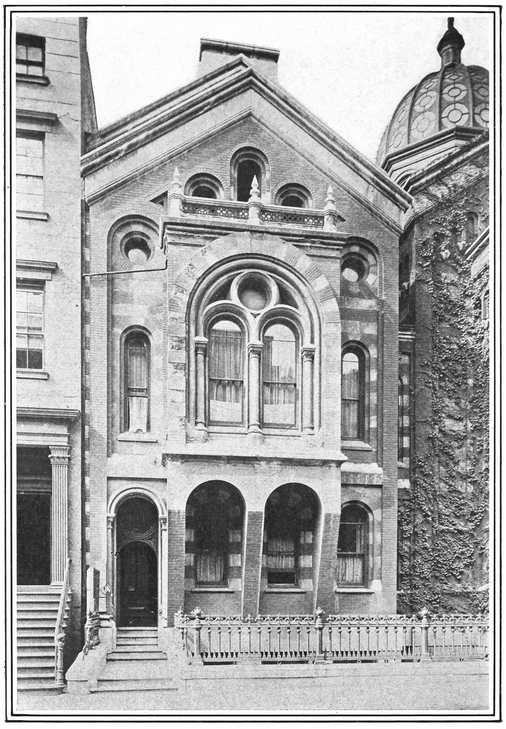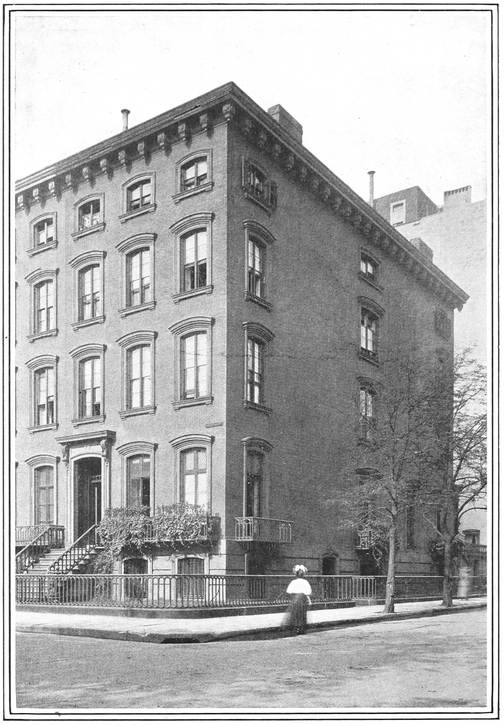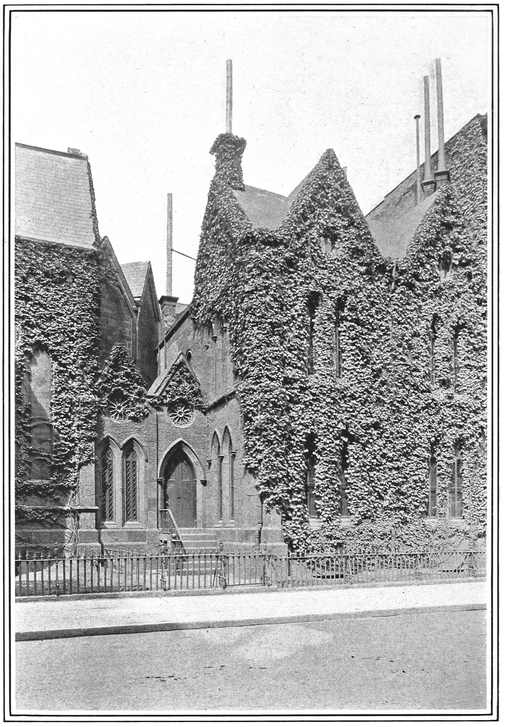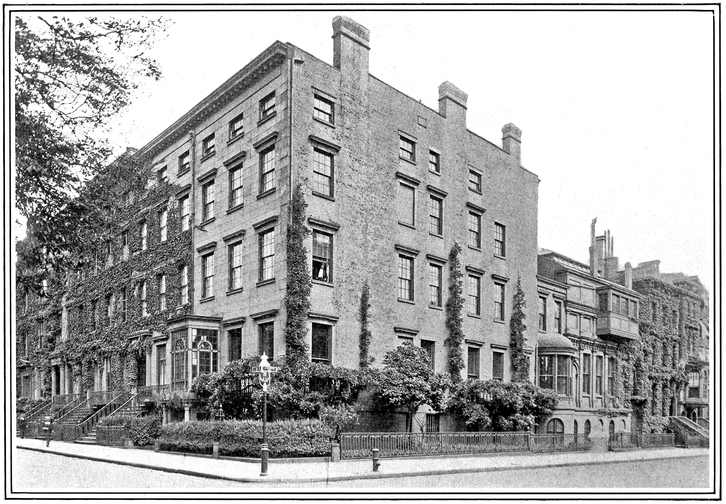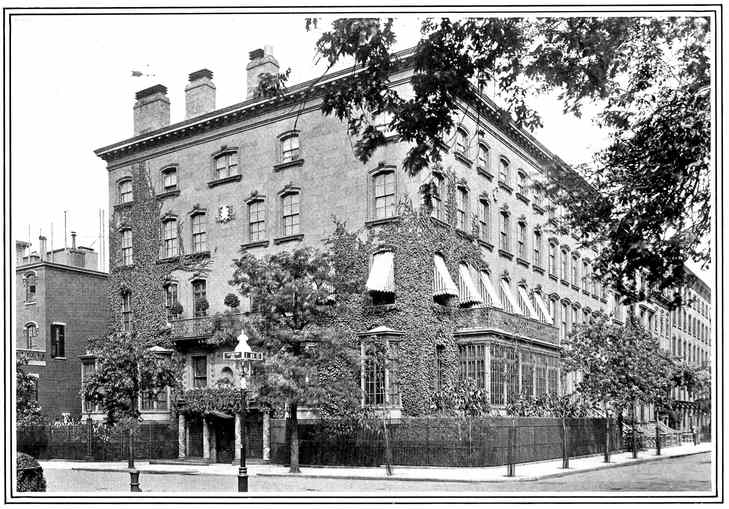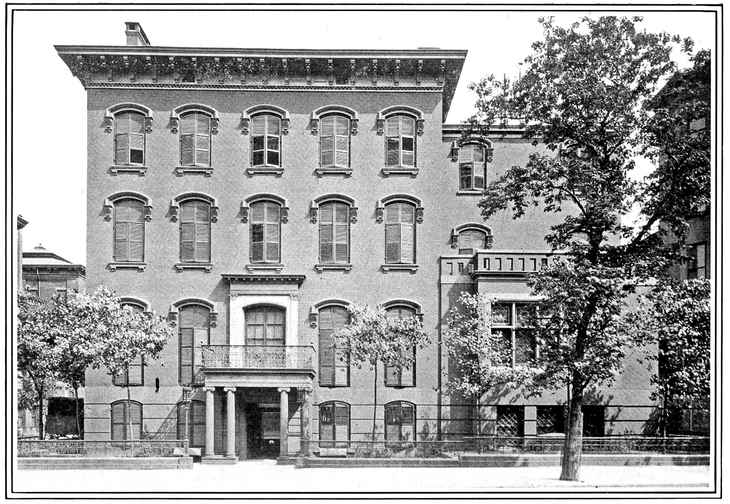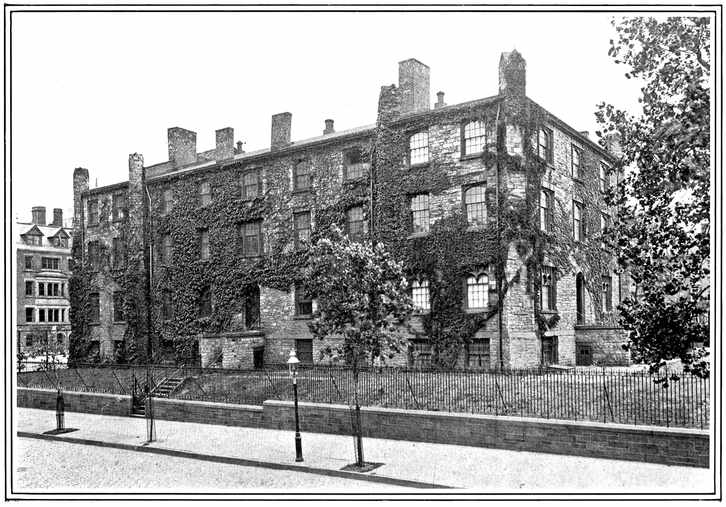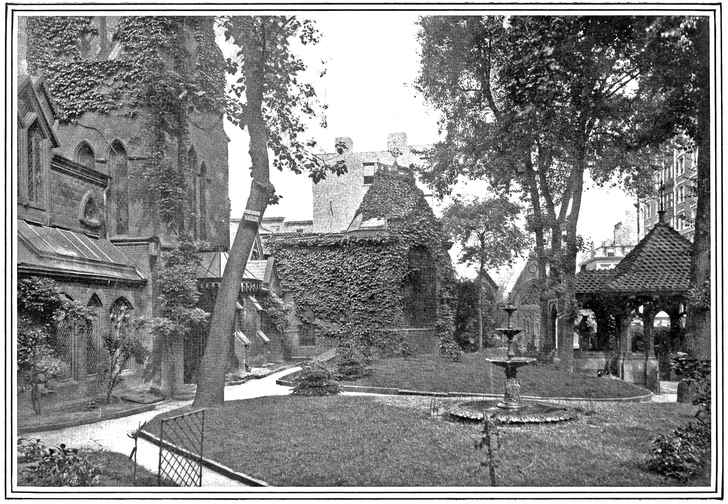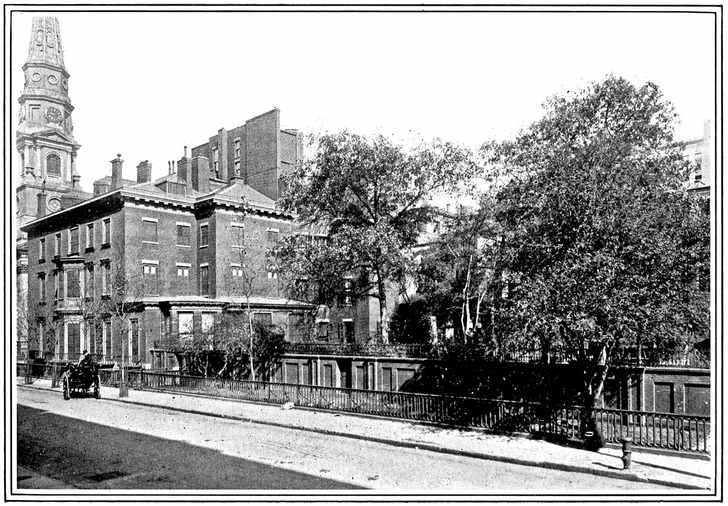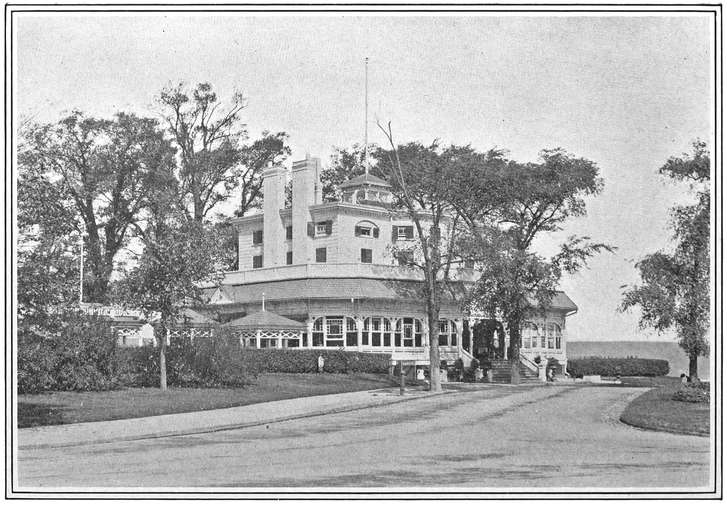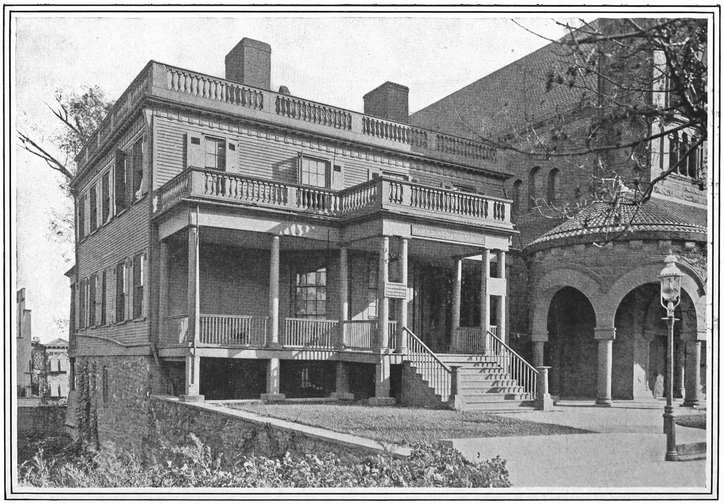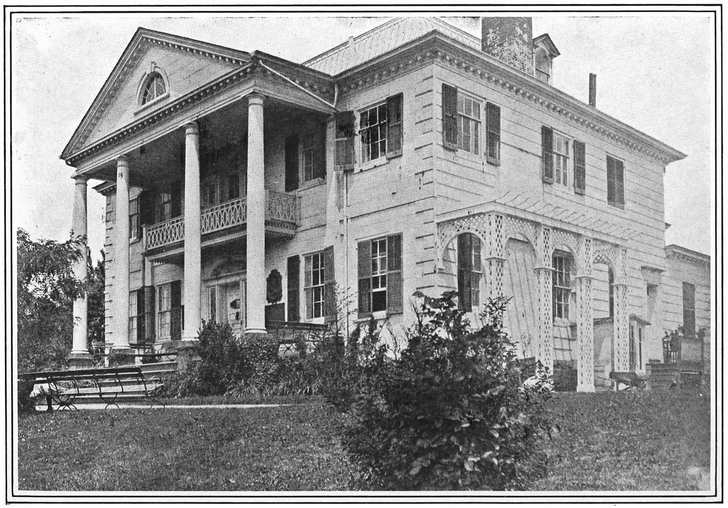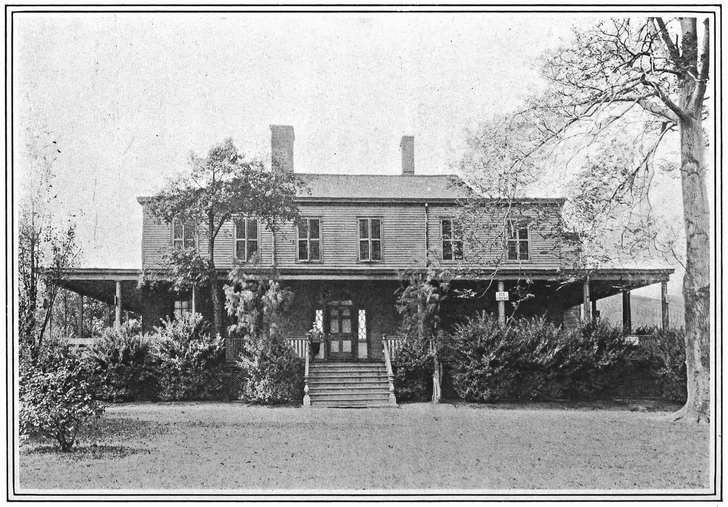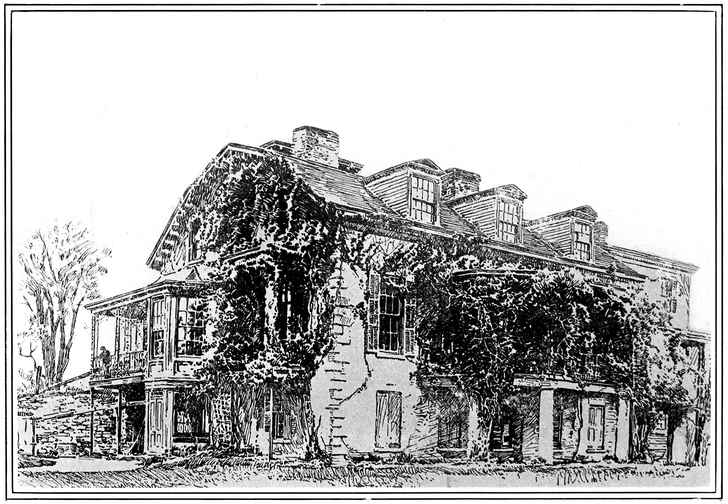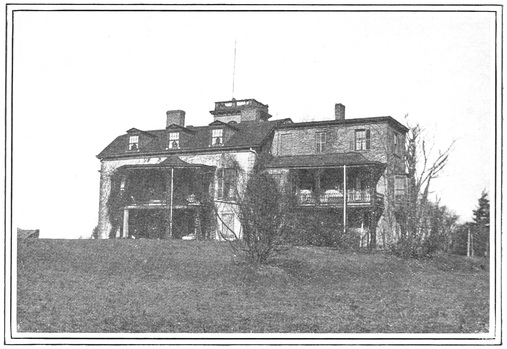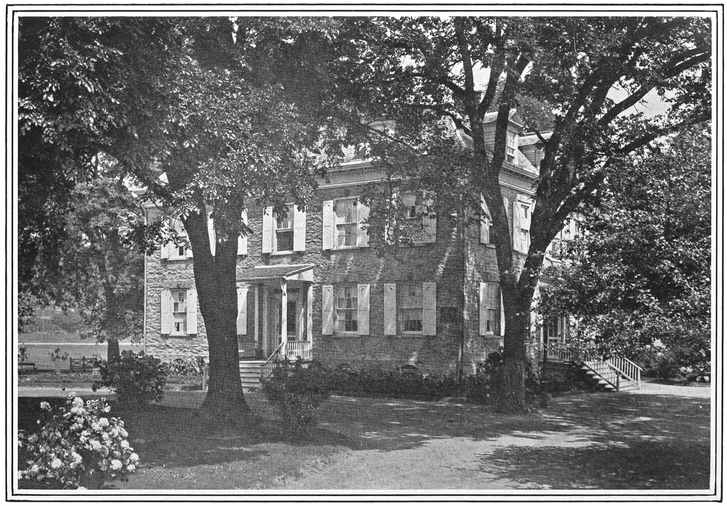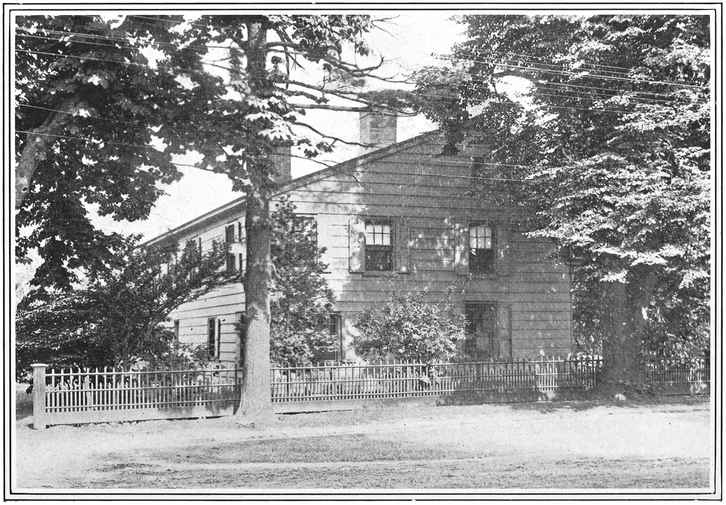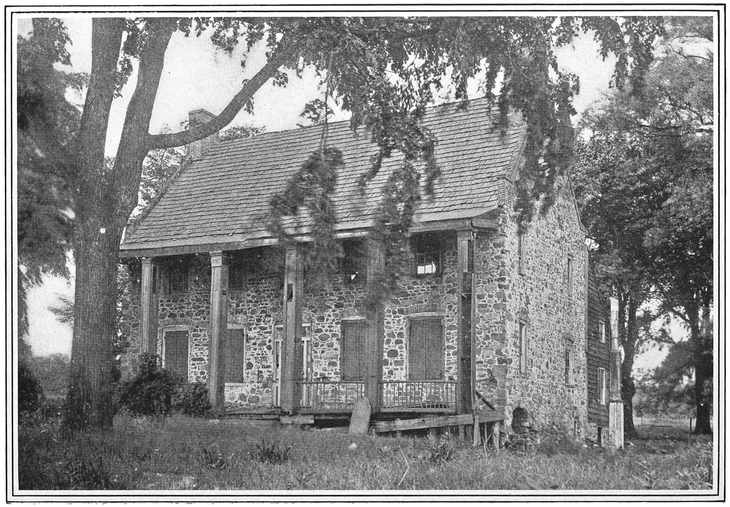*** START OF THE PROJECT GUTENBERG EBOOK 60342 ***
Transcriber’s Note
Cover created by Transcriber by adding a photograph
from the original book to the Title Page of the
original book. The result remains in the Public Domain.
Old Buildings
of
New York City
OLD BUILDINGS
OF
NEW YORK CITY
WITH SOME NOTES REGARDING
THEIR ORIGIN AND OCCUPANTS
NEW YORK
BRENTANO’S
MCMVII
Copyright, 1907, by Brentano’s
THE TROW PRESS, NEW YORK
Subjects
| BOROUGH OF MANHATTAN |
| |
PAGE |
| Number Seven State Street |
19 |
| Fraunces’s Tavern |
23 |
| Sub-Treasury and Assay Office |
27 |
| Bank of New York |
29 |
| St. Paul’s Chapel |
33 |
| City Hall |
39 |
| Astor Library |
43 |
| Langdon House |
45 |
| St. Mark’s Church |
49 |
| Rutherfurd House |
53 |
| Keteltas House |
57 |
| Residence of Eugene Delano |
59 |
| First Presbyterian Church |
61 |
| Former Residence of the Late James Lenox |
63 |
| Former Residence of the Late Robert B. Minturn |
65 |
| Grace Church |
67 |
| Society Library |
69 |
| Cruger House |
73 |
| Abingdon Square |
77 |
| Gramercy Square |
81 |
| Residence of John Bigelow |
83 |
| Former Residence of the Late Luther C. Clark |
85 |
| Former Residence Of the Late James W. Gerard |
87 |
| “The Players”—Former Home of Edwin Booth |
91 |
| Former Residence of the Late Samuel J. Tilden |
936 |
| Former Residence of the Late Rev. Dr. H. W. Bellows |
97 |
| Former Residence of the Late Dr. Valentine Mott |
99 |
| Rectory of Calvary Parish |
101 |
| Former Residence of the Late Stanford White |
103 |
| Former Residence of the Late Cyrus W. Field and the Late David Dudley Field |
105 |
| Former Residence of the Late Peter Cooper and the Late Abram S. Hewitt |
107 |
| General Theological Seminary |
111 |
| Former Residence of the Late William C. Schermerhorn |
115 |
| Church of the Transfiguration |
117 |
| Residence of J. Pierpont Morgan |
121 |
| Former Residence of the Late Theodore A. Havemeyer |
123 |
| Former Residence of the Late Senator Edwin D. Morgan |
125 |
| The Old Arsenal |
127 |
| Claremont |
129 |
| Hamilton Grange |
139 |
| Jumel House |
143 |
| Gracie House |
151 |
| BOROUGH OF THE BRONX |
| Gouverneur Morris House |
157 |
| Van Cortlandt House |
167 |
| BOROUGH OF QUEENS |
| Bowne House |
171 |
| BOROUGH OF RICHMOND |
| Billop House |
175 |
7
Old Buildings
of
New York City
9
Introductory
Recently a writer in a periodical stated that
“No one was ever born in New York.” It
can be safely said that this is an exaggeration.
Nevertheless it showed the confidence of the writer that
the statement was not likely to startle his readers very
greatly.
Probably not one in a hundred of the men in the
street know or care anything about the town of fifty
or sixty years ago. Still the number of those who were
familiar with it then is large, however small in comparison
with the whole number. In fact, the number of
those whose predecessors were living here when there
were not more than a thousand people in the whole place
is much greater than is generally supposed.
It was for people belonging to the two latter classes
that these pictures were taken. They may even interest
some who have known the town for only a generation.
When a man has traversed the streets of a city for
fifty years, certain buildings become familiar landmarks.
He first saw them perhaps on trudging to school with
his books, and has seen them nearly every day since.
He experiences a slight shock whenever such buildings
are destroyed. There appears something wrong in the
general aspect of the town. Of late years these shocks10
have followed one another so continuously that he may
well wonder whether he is living in the same place.
It occurred to the writer that it would do no harm
to preserve the pictures of some of the landmarks still
standing, especially as they are getting fewer in number
all the time, and may shortly disappear altogether.
He regrets that he is unable to show a photographic
presentment of many buildings that have disappeared
in the last fifty years, or even during the life of the
present generation. Some buildings that had a certain
historical interest have been razed in the last twenty-five
years, as, e. g., the Kennedy house,1 No. 1 Broadway,
taken down to make way for the Washington Building,
overlooking the Battery Park, or the old Walton house2
in Pearl Street near Franklin Square, removed in 1881,
or the Tombs prison, removed in 1899.
11
Among buildings that will be recalled to memory
by the older citizens it would have been a satisfaction
to have been able to show pictures of the Brick (Presbyterian)
Church, that stood, with its yard, on Park
Row, taking in the block bounded by Spruce, Nassau,
and Beekman streets; or Burton’s Theater in Chambers
Street; the Irving House, later Delmonico’s, on the corner
of Broadway and the same street; of the old New
York Hospital on Broadway near Thomas Street, standing
far back with its beautiful lawn and grand old trees;
of the St. Nicholas Hotel near Spring Street; of the
old Coster mansion (later a Chinese museum), built of
granite in the style of the Astor House, near Prince
Street; and Tiffany’s place across the way, with the
same Atlas upholding the clock over the door; of the
Metropolitan Hotel on the next block with Niblo’s Garden;
of Bleecker Street with Depau Row;3 of Bond
Street with the large Ward (later Sampson) residence
on the corner; the Russell residence on the corner of
Great Jones Street; the famous old New York Hotel;
the Lorillard mansion at Tenth Street; the large
brownstone residence of Judge James Roosevelt, near
Thirteenth Street, famous for the hospitality of its
owners, and the red brick residence of Cornelius V. S.
Roosevelt, grandfather of the President, on the corner12
of Union Square, having the entrance on Broadway.
The older resident can recall Union Square when the
buildings were nearly all private residences, conspicuous
among which were the Parish house on the north side
and the Penniman (later the Maison Dorée) on the
south. He can recall the stately appearance of Fourteenth
Street westward of Union Square: the Haight
residence on the corner of Fifth Avenue and Fifteenth
Street, with its large winter garden;4 the brownstone
house of Colonel Herman Thorn in Sixteenth Street,
west of the avenue, standing in its wide grounds (now
nearly filled by the New York Hospital); the residence
of Mr. and Mrs. August Belmont (so long leaders in
society), on the avenue, at the corner of Eighteenth
Street, extending with its picture gallery a long distance
on the street; the Stuart residence, which shared the
block above Twentieth Street with a church; and then
the Union Club house at Twenty-first Street. Perhaps
of all the landmarks taken down during the time of the
present generation, none was so well known as the Goelet
house at Broadway and Nineteenth Street, with the
grounds extending eastward toward Fourth Avenue.
Thousands of people passed every day in the short
stretch between the two squares. Mr. Peter Goelet’s
penchant for rare and beautiful birds was a never-ending
delight to every passing child and adult, and13
a number were always standing gazing past the iron
railing. Peacocks white and blue, Chinese golden
pheasants, and many other varieties found a comfortable
home in the grounds.
The appearance of the entire city now gives the
impression of life and bustle. With the exception of
Gramercy Square and Irving Place, there is hardly a
spot in the lower part of the city that now has any
appearance of repose. Thirty years ago the city presented
a wholly different aspect. Fifth Avenue, from
Washington to Madison Square, was, in the opinion of
the writer, one of the finest residence streets anywhere.
At most hours of the day the people on the sidewalks
were comparatively few and there was a very small proportion
of business wagons and trucks that used the
roadway as compared with the numbers that do so to-day.
University Place was a street of nearly the same
character, as was also Second Avenue from Seventh
Street to Stuyvesant Square. This street had a charm
of its own. Lined as it was on either side with spacious
residences, it gave the impression of a street of homes.
The façades of the largest houses were simple and unpretentious,
forming a marked contrast to some of the
houses uptown to-day.
As regards the matter of repose, it may be said that
twenty-five years ago the palm would clearly have been
given to Lafayette Place. This short street also had a
character of its own. From the Langdon house on the
east side near Astor Place to old St. Bartholomew’s14
Church at Great Jones Street, and from the Langdon
(Wilks) house on the west side to the Schermerhorn
house opposite the church, almost every building had
its individuality. The street was marred by three or
four ancient buildings, which for some reason were not
removed, such as the stable between the Langdon house
and the Astor Library, once the favorite Riding Academy.
The Library still (1906) stands, as does a part
of the old Colonnade, but an earthquake could hardly
have wrought greater changes than has the march of
trade.
The large mansion of the first John Jacob Astor
stood separated from the Library by a gateway and
broad alley reaching to the stables in the rear. Adjoining
was a group of houses of the style of those in
Washington Square, broad and “high-stooped.” Opposite,
on the corner of Fourth Street, stood a church
whose portico of granite Ionic columns (each a monolith
brought with great trouble from Maine) was one of the
wonders of the town. Almost adjoining was the Swan
residence, since converted into the Church House of the
diocese, and then the Colonnade with its long row of
granite Corinthian columns, considered a marvel in its
day. Next to these was the “English basement” house
of the late Charles Astor Bristed, with arch and driveway
leading to the rear, and on the corner the Langdon
(Wilks) house, when it was built, the finest in town.
Being a short street, blocked at one end and leading
only to Astor Place at the other, the drivers of very15
few vehicles ever took the trouble to turn into it, except
the driver of a private carriage, perhaps a closed
coach drawn by heavy horses (for the cobble stones were
rough); the coachman on a vast hammercloth embellished
with fringes and tassels, as was frequently seen
forty years ago, the footman sometimes standing behind,
his hands grasping two leather loops to hold himself in
place. So quiet was the street that on a pleasant afternoon
the youngsters who dwelt in the neighborhood carried
on their game of ball undisturbed. Perhaps it was
this feature of quiet repose which suggested the suitability
of establishing there the Library, the churches, the
Columbia College Law School, and the Church House.
The writer might go on and refer extensively to
other ancient streets and the changed aspect of other
places throughout the city, but that is not his present
purpose.
There are a few old landmarks that are likely to
stand, for example the City Hall, in the opinion of
some the most successful building, as to architectural
design, in the country.
Abandoned to materialism as the city is and lacking
sentiment, nevertheless any proposal to take down the
City Hall, or even to alter it ever so slightly, meets
with vigorous protests.5
16
Possibly people might object if it were proposed to
destroy St. Paul’s Chapel, the oldest church edifice in
the city, and so with a few other buildings; but the
majority of the landmarks must go and hideous skyscrapers
arise, “monuments to greed” as they have been
termed, half ruining adjacent properties.
It was with a view of preserving the appearance of
some of these landmarks that may be torn down any
day that these pictures were taken. Endeavor has been
made to present those that have been in existence about
fifty years. With two exceptions the buildings represented
are now (1906) standing.
Mistakes and errors no doubt appear in the text, and
these the writer would be glad to correct. The notes
in no sense profess to be thorough. They are, for the
most part, mere skeletons of what may be said upon the
subjects dealt with.
18
19
Number Seven State Street
This house was built by Moses Rogers, a prominent
merchant of the latter part of the eighteenth
and the first part of the nineteenth century.
He was a native of Connecticut, his mother being
a daughter of Governor Fitch of that State. He was
in business as early as 1785 at 26 Queen (Pearl) Street.
In 1793 the firm name was Rogers & Woolsey, his partner
being William Walter Woolsey, his brother-in-law,
Mr. Rogers having married Sarah Woolsey, a sister of
the wife of President Dwight of Yale College. In that
year he was living at 272 Pearl Street, near Beekman,
“in a large house with hanging garden extending over
the yard and stable.”6
Mr. Rogers was a merchant of high character and
public spirit. In 1793 he was an active member of the
Society for the Manumission of Slaves. He was a governor
of the New York Hospital from 1792 to 1799,
and in 1797 treasurer of the City Dispensary. From
1787 until 1811 he was a vestryman of Trinity Church,
and in 1793 was a member of the Society for the Relief
of Distressed Prisoners.7
20
In the year 1806 he was living in the house here
presented. His sister had married the celebrated merchant
and ship owner, Archibald Gracie. His children
were: (1) Sarah E. Rogers, who married the Hon.
Samuel M. Hopkins; (2) Benjamin Woolsey Rogers,
who married Susan, daughter of William Bayard; (3)
Archibald Rogers, who married Anna, daughter of
Judge Nathaniel Pendleton; and (4) Julia A. Rogers,
who married Francis Bayard Winthrop.8 In the year
1826 Benjamin Woolsey Rogers was living in the next
house, Number Five State Street, but after his father’s
death he moved to Number Seven and lived there until
1830.9 William P. Van Rensselaer, grandson of General
Stephen Van Rensselaer, married successively two
of the daughters of Mr. Rogers. The house during the
ownership of the Rogers family was the scene of many
notable entertainments. These entertainments were frequently
referred to by older members of society who
have now passed away. In 1830 the house was occupied
by Gardiner G. Howland.
The queerly shaped front was to a certain extent a
necessity. State Street takes a sharp turn and the house
was built at the apex of an angle. The interior was
doubtless an improvement on other houses. The ceilings21
were high, and the staircase, instead of being in
the hall as in older houses, is at the side. It is winding,
of an oval design, with mahogany balustrade. The skylight
was of stained glass, made in England, showing
the coat of arms.
During the Civil War, the house was taken by the
Government for military uses, and afterwards became
the office of the Pilot Commissioners.
It is now the house of the mission of Our Lady of
the Rosary.
22
23
Fraunces’s Tavern

In the year 1671 Col. Stephen Van Cortlandt
built a cottage on the corner of Broad and
Pearl (then Queen) streets, to which he brought
his bride, Gertrude Schuyler. The house overlooked the
waters of the river and bay. In the year 1700 he deeded
this property to his son-in-law, Etienne de Lancey, probably
wishing to retire to his manor on the Hudson. De
Lancey was a French Huguenot of rank who had left
his native country on the revocation of the edict of
Nantes. He came to New York where he established
himself as a merchant. On these premises he built a
hip-roofed mansion several stories in height, of small
yellow bricks imported from Holland. In dimensions
and arrangement it ranked among the best in the colony.
The property descended through his son James
to his grandson Oliver. This part of the town having
by that time become the business quarter in 1757, the
house was abandoned as a residence and became the
warehouse of De Lancey, Robinson & Co. On January
17, 1762, the building was transferred to Samuel
Fraunces, who converted it into a tavern under the name
of the “Queen’s Head,” and announced that dinner
would be served daily at half-past one. In April, 1768,24
in the long room, the Chamber of Commerce was inaugurated
with John Cruger as president.
On November 25, 1783, the day of the evacuation
of the British, a grand banquet was given by Governor
Clinton to General Washington and the French minister,
Luzerne, and in the evening the “Queen’s Head”
and the whole town were illuminated. More than a
hundred generals, officers, and distinguished personages
attended the banquet and thirteen toasts were drunk
commemorative of the occasion. Ten days later Washington
here met his generals for the last time. After
a slight repast Washington filled his glass and addressed
his officers as follows: “With a heart full of love and
gratitude, I must now take my leave of you. I most
devoutly wish that your latter days may be as prosperous
and happy as your former ones have been glorious
and honorable.”10 In silence his former companions
then took a final farewell of their chief.
This is one of the oldest buildings in the city, as the
great fire of 1776 doubtless swept away most of those
of earlier date. During the last century the building
has gone through various vicissitudes, mostly on the descending
scale. A year or two ago the ground floor was
occupied by a saloon. Lately the building has been
completely restored by the Sons of the Revolution and
now presents very nearly its original appearance.
26
27
Sub-Treasury and Assay Office
The Sub-Treasury is built on the site of the original
City Hall. In 1789 this was altered and
repaired for the use of the first Congress and
named the Federal Hall. The balcony of the Hall was
the scene of Washington’s inauguration as President,
in commemoration of which the statue was erected.
In 1834 the building was demolished and the present
structure erected for the Custom House and was
used as such until 1862.
The Assay Office is the oldest building in Wall
Street, having been built in 1823, for the New York
branch of the Bank of the United States. It became
the Assay Office in 1853.
28
29
Bank of New York
The oldest bank in the country is the Bank of
North America in Philadelphia, incorporated
by act of Congress, December, 1781, and by
the State of Pennsylvania a few months afterwards.
Very great losses had occurred from the repudiation
of the Continental bills of credit. All the States had
issued bills of their own and kept on “making experiments
in finance which did not depend on specie as a
basis.” Currency was expressed in pounds, shillings,
and pence and the currency in circulation was a motley
conglomeration of guineas, doubloons, pistoles, Johannes
pieces, moidores, and sequins. Thus arose the necessity
of a bank that should both assist the Government
and benefit the people at large.
On February 26, 1784, a meeting of the principal
merchants and citizens was held at the Merchants’ Coffee
House. General Alexander McDougal was chosen
chairman, and it was unanimously decided to establish
a bank. Subscription books were opened at the offices
of John Alsop, Broadway, Robert Bowne, Queen Street,
and Nicholas Low, Water Street, and the shares were
rapidly taken.
On March 15, 1784, the following officers were
chosen: General Alexander McDougal, president; Samuel
Franklin, Robert Bowne, Comfort Sands, Alexander30
Hamilton, Joshua Waddington, Thomas Randall,
William Maxwell, Nicholas Low, Daniel McCormick,
Isaac Roosevelt, John Vanderbilt, and Thomas B.
Stoughton, directors; and William Seton, cashier.
The bank commenced business at what was formerly
the old Walton house in St. George’s (now Franklin)
Square. It stood on the east side of Queen (now Pearl)
Street, almost opposite the present establishment of
Harper Brothers, the publishers. The building (erected
1752) will be remembered by many people to-day as it
was only taken down in 1881, but its appearance during
its declining years gave a faint idea of its original
dignity. In 1787 the business of the bank was moved
to Hanover Square, Isaac Roosevelt having been chosen
president in 1786.
In 1796 a lot was bought at the corner of Wall and
William streets from William Constable for eleven thousand
pounds (New York currency). Strange to say,
there is no record of the dimensions of the lot, but the
present building doubtless stands on part of it.
Early in 1797 steps were taken to remove the house
then standing and to put up a new building, and the
corner stone was laid by Gulian Verplanck, then president,
on June 27th. Mr. Verplanck died in 1799 and
Nicholas Gouverneur was chosen president. The corner
stone of the present building was laid on September
10, 1856, and the building completed in 1858.11
32
33
St. Paul’s Chapel
This chapel built in 1764–66 is the oldest church
edifice in the city. The first rector was the
Rev. Dr. Barclay, who was succeeded by the
Rev. Dr. Samuel Auchmuty. The steeple is in the style
of one of Wren’s designs. After the burning of Trinity
in 1776, it was used as the parish church. The pews
that during the war held Howe, André, the officers of
the army of occupation, and the young midshipman who
later became King William IV were, when peace was
concluded, occupied by the former “rebels” Washington,
Clinton, and their followers. After his inauguration,
in the Federal Hall in Wall Street, Washington
and the members of both houses came in solemn procession
to St. Paul’s, where services were conducted by
Bishop Provost, Chaplain of the Senate, and a Te Deum
was sung.
The square pew on the left with the national arms
on the wall was the one used by Washington as long
as New York remained the capital. The corresponding
pew on the right, designated by the arms of the State,
was that of Governor Clinton. On the chancel wall are
marble tablets to Sir John Temple, the first British
consul general, and to Colonel Thomas Barclay, the
eminent loyalist, son of the Rev. Dr. Barclay, rector34
of Trinity Parish. Colonel Barclay succeeded Temple
as consul general of “His Brittanick Majesty.” There
is also a tablet in memory of the wife of William Franklin,
Tory Governor of New Jersey, and several others.
The only other reminder of pre-Revolutionary days is
the gilded crest of the Prince of Wales over the pulpit
canopy. As everyone knows, at the east end of the
yard facing Broadway are monuments to three eminent
Irishmen who rose to distinction in this country—Emmet,
Montgomery, and MacNeven, one at the bar, another
in the army, and the third in medicine. Emmet
was the brother of the Irish martyr, Robert Emmet;12
Montgomery settled in New York before the Revolution,
married a daughter of Chancellor Livingston and
fell at Quebec;13 MacNeven, like Emmet, had taken35
part in the Irish rebellion of ’98, acting with him as
one of the Directory of Three. Both were imprisoned36
at Fort George in Scotland. He later served in Napoleon’s
army as surgeon.
George W. P. Custis, who was one of Washington’s
family, spoke of St. Paul’s as being “quite out of
town.” No doubt the great fire of 1776, which stopped
when it got to the Chapel yard, left the Chapel standing
isolated from buildings below it; but Custis, to get
there from St. George’s (Franklin) Square, must have
had to go some distance “down town.” It tends to show
that the water front of the city was covered with buildings
before the central part. The fact that the commissioners
for making a plan of the future city early in
the last century arranged for so many streets running
to the water and for so few running north and south
would also seem to indicate that they thought easy access
to the rivers was of prime importance.
Mr. Astor, with his wonderful foresight, was the
first man to realize that the “backbone” of the island
was, in after years, to show the greatest advance in the
value of real estate.
38
39
The City Hall
The plans of the architect who designed the
City Hall, John McComb, were accepted in
the year 1803, but the building was not completed
until nine years later.
It is not always an agreeable business to devote one’s
time to destroying a myth which has become lodged in
the affections of the people, but sometimes it rests on
so slight a foundation that there is nothing gained in
keeping it alive. We have lately seen how the tradition
that Washington Irving used to live in the house
on the corner of Irving Place and Seventeenth Street
had no foundation in fact, except that he had a nephew
who lived next door. And so the story so often repeated
in newspapers and guide books that the City Hall was
finished in brownstone at the back because the city fathers
thought that nobody of any importance would ever
live to the north of it might, it seems, be set at rest,
although the attempt is not made for the first time.
The story reflects on the intelligence of the people of
the day. The reason was economy, but not joined to
deficiency of foresight.
The Common Council of that day, instead of being
obtuse on the subject were quite the other way, and
show by their records that they took a highly optimistic40
view of what they call the city’s “unrivaled” situation
and opulence. They state their belief that in a very few
years the hall that they were about to build would be
the center of the wealth and population of the city. It
was at first arranged to build entirely of brownstone,
and the contractors got their work done as far as the
basement, as can readily be seen to-day. Then the views
of the Common Council underwent a change. A halt
was made and McComb was requested to make an estimate
of the cost in marble.
From an interesting article appearing in the Century
Magazine for April, 1884, written by Mr. Edward S.
Wilde, it seems that the committee’s report states: “It
appears from this (the architect’s) estimate that the
difference of expense between marble and brownstone
will not exceed the sum of $43,750, including every
contingent charge. When it is considered that the City
of New York from its inviting situation and increasing
opulence, stands unrivaled ... we certainly ought, in
this pleasing state of things, to possess at least one public
edifice which shall vie with the many now erected in
Philadelphia and elsewhere ... in the course of a very
few years it is destined to be the center of the wealth
and population of the city. Under these impressions
the Building Committee strongly recommend that the
front and two end views of the new hall be built of
marble.”
The corporation then authorized the use of marble
on three fronts. The brownstone of the rear received41
its first coat of white paint only a few years ago, as
nearly anyone who reads this can testify. In 1858 the
cupola was destroyed by fire and was restored in a poor
manner, but Mr. Wilde says: “Notwithstanding this
change and the damage done less by time than by stupidity,
the hall stands to-day unsurpassed by any structure
of the kind in the country.”
42
43
Astor Library
The Astor Library was founded in accordance
with the terms of a codicil to the will of the
first John Jacob Astor. It was opened in
1854. His son William B. Astor added a wing to the
original building (the present central portion) and presented
five hundred and fifty thousand dollars to the
library fund.
In 1881 another wing was added by his grandson,
John Jacob Astor.
44
45
The Langdon House

This house was usually called the Langdon
house, although it was never occupied by the
family of that name. Mr. Walter Langdon’s
house, directly opposite, was built much later. About
1845 the first John Jacob Astor wished to present his
daughter, Mrs. Walter Langdon, with a city residence
and built this house for her during her absence abroad.
He built merely the shell of the house, and on his daughter’s
return gave her the sum of thirty thousand dollars
for the purpose of decorating it. Carte blanche was
given to a famous decorator of that day, and he proceeded
to finish it in a style hitherto unknown in the city.
The result was that in the end the cost of the interior
had risen to sixty thousand dollars, considered a very
large sum at that time. A great deal of attention was
paid to plaster and stucco ornamentation and woodwork.
The most attractive feature of the house was the main
staircase, which was made in England especially for the
house. This staircase was rectangular and of a dark
rich colored wood, was beautifully carved and of a very
graceful design. It was lighted by a large stained-glass
window overlooking Astor Place. The reception
rooms were on the left of the main hall with a conservatory
in the rear. At the right were the library, staircase,46
dining room, and offices. Mrs. Langdon, however,
returned to Europe and continued to reside there until
her death. Meanwhile it was arranged that the house
should be occupied by her daughter, who had married
an English gentleman, Mr. Matthew Wilks. Mr. and
Mrs. Wilks continued to live there until the house was
taken down in 1875.
The property had a frontage of about two hundred
and fifty feet on both Astor Place and Lafayette Place
(now Lafayette Street), from which it was shut off
by a high wall. The enclosed courtyard was laid out
as a garden, with large trees, and the rear was occupied
by the stables. The garden contained a ring large
enough for riding purposes.
Of course during the Forrest-Macready riot in 1849
the house was almost in what might be called the storm
center. In the midst of it one of the servants, who
thought he had secured a perfectly safe point of observation
on the roof, was killed.
48
49
St. Mark’s in the Bowery
When Stuyvesant retired from office, after the
British occupation, he withdrew to his “Bowerie”
or farm near the site of the present
church, then two miles out of town. In 1660 he built
a small chapel near his house for the people of the little
village that sprang up about the farm, as well as for
his own family and the slaves, of whom there were
about forty in the vicinity. This chapel was torn down
in 1793, and the Petrus Stuyvesant of that day offered
to present the ground and eight hundred pounds in
money to Trinity parish if it would build a church
there. This offer was accepted. In May, 1799, the
church was finished and the body of it has remained
intact to the present time, but there was no steeple
before 1828. One pew was reserved for the governor
of the State, and the corresponding pew on the
other side for “Mr. Stuyvesant and family forever,”14
each pew being surmounted by a canopy.15 The negro
servants (slaves) sat in the rear of the congregation.
In a vault under the chapel the governor’s body had
been placed after his death, in 1672, and in 1691 the50
body of the English governor (Sloughter) was also
placed there.
In building the church Stuyvesant’s remains were
removed and placed in a vault beneath the walls of the
new edifice. The stone which may be seen fastened to
the outer wall bears the following inscription: “In this
vault lies buried Petrus Stuyvesant, late Captain General
and Governor in Chief of Amsterdam in New
Netherlands, now called New York, and the Dutch
West India Islands, died A.D. 1671–2, aged 80 years.”
In July, 1804, the church was draped in mourning
for the death of Hamilton, and was so kept for six
weeks.
52
53
Second Avenue
Former Residence of the Late Lewis M. Rutherfurd

Lewis M. Rutherfurd was one of the
most noted astronomers that this country has
produced. As a young man, he began the
study of the law with William H. Seward, and was
admitted to the bar in 1837 and became associated with
John Jay and afterwards with Hamilton Fish. But
his tastes were entirely in the direction of science, and
he decided to abandon the law and apply his attention
to scientific research. With ample means, he had full
opportunity to devote his life to the pursuit of his favorite
study, astronomical photography. He spent several
years of study in Europe and, on his return, he built
an observatory in New York, the best equipped private
astronomical observatory in the country. He made with
his own hands an equatorial telescope and devised a
means of adapting it for photographic use by means of
a third lens placed outside of the ordinary object glass.
He was the first to devise and construct micrometer apparatus
for measuring impressions on the plate. It is
said that he took such pains in the construction of the
threads of the screws of his micrometer that he was
engaged three years upon a single screw. He worked
for many years at the photographic method of observation54
before the value and importance of his labors were
recognized, but in 1865 these were fully acknowledged
by the National Academy of Sciences. The remarkable
results that he obtained were all secured before the
discovery of the dry-plate process. His photographs
of the moon surpassed all others that had been made.
When overtaken by ill health he presented his instrument
and photographs to Columbia College, and his
telescope is now mounted in the observatory of that
university.
He was an associate of the Royal Astronomical Society,
president of the American Photographical Society,
and was the American delegate to the International
Meridian Conference at Washington in 1885, preparing
the resolutions embodying the results of the labors of
the conference. He received many decorations and
honors from the learned societies of the world, but his
dislike of ostentation was such that he was never known
to wear one of the decorations, emblems, etc., that were
conferred upon him.16
The Mansard roof has been added to the house since
its occupation by the Rutherfurd family and the entrance
removed from the avenue to the side street.
When the house and grounds of the late Hon.
Hamilton Fish, on Stuyvesant Square, were sold a
few years ago, it was said that there had been no transfer
of the site except by devise or descent since the time
of the old Governor. The same might be said of this55
property. Stuyvesant’s house, in which, it is said, the
papers were signed transferring the province to the
British Crown, stood close to this spot. The house is
the property of Rutherfurd Stuyvesant, a son of Lewis
M. Rutherfurd.
56
57
The Keteltas House
An example of an old Second Avenue dwelling,
the residence of the Keteltas family on the
corner of St. Mark’s Place.
58
59
Washington Square
Residence of Eugene Delano
This house was formed by uniting two of the
fine old residences on the north side of Washington
Square. The interior has been admirably
reconstructed. The house was formerly occupied
by Edward Cooper (son of the late Peter Cooper),
who was, at one time, Mayor of the City.
60
61
First Presbyterian Church, Fifth Avenue
This church, representing the oldest Presbyterian
organization in the city, was formed in
1716. The building was erected in 1845.
62
64
66
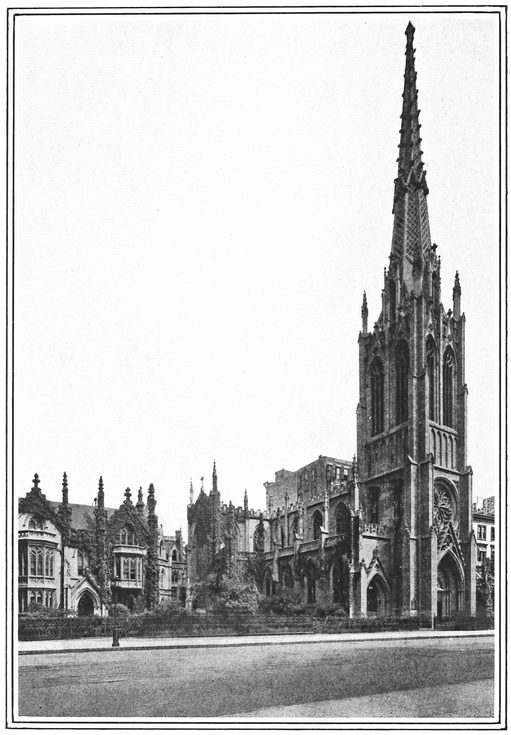
Grace Church, Broadway
68
69
The Society Library

In the year 1700 the Public Library of New
York was founded under the administration
of the Earl of Bellomont, and seems to have
progressed as the city grew, being aided from time to
time by gifts from interested persons on the other side,
several folio volumes now in the Society Library having
been presented by friends in London in 1712, and in
1729 the Rev. Dr. Millington, rector of Newington,
England, having bequeathed his library to the Society
for the Propagation of the Gospel in Foreign Parts,
it was presented to the New York Public Library. The
library, being in charge of the corporation of the city,
was evidently not managed in a manner satisfactory to
the people in general. In the year 1754 it was determined
that a more efficient library was a necessity. In
that year the present Society Library had its origin,
and what had been the Public Library of the city was
incorporated with it. Mrs. John King Van Rensselaer18
states that it had its source in a movement started by
Mrs. Alexander, who suggested to some of her friends
that a circulating library should be established, the subscribers
to collect sufficient money to send to England
for the newest and best books. A list was made headed70
by Messrs. William Smith, Philip, William and Robert
Livingston, John Morin Scott and William Alexander.
After subscription books had been opened and the lieutenant
governor (De Lancey) and council had “set
their official seal” on the venture, a considerable sum
was raised and an institution was regularly organized
and later received a charter from Governor Tryon.
Down to the time of the Revolution, the collection was
constantly increased by the purchase of books, but during
the Revolution, with a large part of the city destroyed
by fire and what remained being under the
control of a hostile army, the library suffered greatly.
Mrs. Lamb19 states that “four thousand or more books
disappeared at the outbreak of the Revolution and were
supposed destroyed, but many were hidden away for
safe-keeping and reappeared after the war.”20
In December, 1788, a meeting of the proprietors
was called, trustees were elected, and the library again
resumed operations.
The library was kept in a room in the Federal Hall
in Wall Street and was used as the library of Congress.
The first building put up for its use was on the corner71
of Nassau and Cedar streets in 1795, but the growth of
the city compelling a change, a new building was erected
in 1840 on the corner of Broadway and Leonard Street.
The Library has occupied the present building in University
Place since May, 1856.
The membership of the library has been from the
start among the most prominent and respectable citizens.
Many of the original shares of 1754–58 have
remained in the same families to the present time, as
those of the Auchmuty, Banyer, Beekman, Clarkson,
Cruger, De Peyster, De Lancey, Harrison, Jones,
Keteltas, Lawrence, Livingston, Ludlow, McEvers,
Morris, Ogden, Robinson, Rutherfurd, Smith, Stuyvesant,
Van Horne, and Watts families; and from 1790–96
those of the Astor, Bailey, Barclay, Bowne, Coles, Delafield,
Fish, Gelston, Greenleaf, Jay, Kemble, Kingsland,
Lenox, Low, Lee, Le Roy, Oothout, Peters,
Prime, Ray, Remsen, Roosevelt, Sackett, Schermerhorn,
Schieffelin, Swords, Titus, Townsend, Van Zandt,
Van Wagenen, Van Rensselaer, Verplanck, Waddington,
Winthrop, and Woolsey families.
72
73
Cruger House
Many old New Yorkers remember the Cruger
house in Fourteenth Street about halfway
between Sixth and Seventh avenues, when it
was occupied by the late Mrs. Douglas Cruger.21
The house, having a frontage of seventy-five feet,
stood in the middle of a courtyard extending on either
side about one hundred feet, separated from the street
by a high wall. Now the courtyard has disappeared and
the house, crowded closely on both sides by high buildings,
seems completely dwarfed. Decorated with fire
escapes and signs it has fallen from its high estate, and
the whole street, formerly a quiet dwelling street, is now
nearly given over to trade and noisy bustle. The entrance
hall, twenty-five feet in width, extended from
front to rear eighty-five feet, a wide staircase rising
from the center at the end, the conservatory at the rear
being of the width of the house. The rooms on either
side were rather curiously divided, losing somewhat in
what might have made a more imposing effect, not,
however, enough to prevent their being an excellent74
place for the disposition of the collection of the Metropolitan
Museum, which leased the house in 1873 for five
years. The house is described in the annual report for
that year as a “large and elegant building surrounded
by spacious grounds, upon which grounds new galleries
may be built, should they be required....”22 The
rooms certainly had more unobstructed light than could
be found in most private houses. It is now occupied
by the Salvation Army.
76
77
Abingdon Square—Greenwich
The peculiarity of the Greenwich section of the
town is that it has retained an individuality
that no other section has retained. It is very
much of an American quarter. The streets are lined
with well-kept, comfortable brick houses, dating back
sixty years or more, many of them with the elaborately
ornamental iron railings and newel posts that are disappearing
so rapidly. There is a marked paucity of
the conventional tenement house, and although factories
and warehouses are crowding it on all sides, its people
cling with a stolid determination to their ancient homes.
This square is taken as representative of this quarter
of the city, although it is rather in the streets adjoining
that the houses are most representative of old dwellings
of sixty or seventy years ago. Before the arrival of
Henry Hudson, there was an Indian village here near
the site of Gansevoort Market, but Governor Van
Twiller turned the locality into a tobacco farm. By
1727 it became covered with farms and was joined to
the city by a good road very nearly following the line
of the present Greenwich Street.
The region was always noted for its healthfulness
and when an epidemic of smallpox broke out Admiral
Warren invited the Colonial Assembly to meet at his78
house. This made Greenwich the fashion, and for nearly
a century when epidemics occurred the people flocked
out of town to that village. At one time the Bank
of New York transferred its business there.
No history of this part of the city can be written
without some reference to that bold Irish sailor, Admiral
Sir Peter Warren. Post captain at the age of twenty-four
he, in 1744, while in command of the squadron on
the Leeward Islands station, in less than four months
captured twenty-four prizes, one with a cargo of two
hundred and fifty thousand pounds in plate. He also
served at Louisburg, Gibraltar, and elsewhere. When
at length he tired of a seafaring life, although still
young, he decided upon making his home in New York,
and proceeded to anchor himself for a time at least by
marrying a New York woman, Miss De Lancey. He
bought three hundred acres of land at Greenwich, built
a house and laid out the grounds like an English park.
Here he resided for some years, and then went to England
and entered Parliament.
He died at the age of forty-eight and lies buried in
Westminster Abbey, with a fine monument by Roubillac
above him. After Lady Warren’s death the property
was divided into three lots, one lot going to each of
the three daughters. The lot containing the house fell
to the eldest daughter, Lady Abingdon, and was sold
by her to Abijah Hammond, who afterwards sold it
to the late Abraham Van Nest. The remainder was
sold off in small parcels after three roads had been cut79
through them, the Abingdon, Fitzroy, and Skinner
roads.23 The first corresponds to the present Twenty-first
Street, the second was almost on a line with Eighth
Avenue, and the third was part of the present Christopher
Street.
81
Gramercy Square
Now that St. John’s Park has been destroyed,
Gramercy Park is the only private park in
the city—that is, one restricted in its use to
owners of houses facing it. Fifty years ago it had
more seclusion. A high and dense hedge surrounded
it on the inside of the iron fence. For some reason
this was removed and never replanted. Now people in
the park might almost as well be in the middle of the
street. The figure on the fountain was then a Hebe
perpetually filling her cup with water. In former days
the children that played in the grounds had an annual
May festival on the first of the month. One of the
young girls was chosen queen. Dressed in white and
crowned with flowers, she led the festivities around the
Maypole, under the trees. Later they all withdrew to
the house of her parents, where a collation was served
and the dancing continued until the children were sent
home by their parents and to bed.
A number of men who have been prominent in the
city’s life are living or have lived in houses about the
square. We might mention John Bigelow, Stuyvesant
Fish, James W. Gerard, Edwin Booth, Samuel J.
Tilden, Dr. Bellows, Dr. Valentine Mott, Cyrus W.
Field, and David Dudley Field.
82
83
Gramercy Square
Residence of John Bigelow
Mr. Bigelow, one of the best-known citizens
of New York, was admitted to the bar in 1839
and in 1850 joined William Cullen Bryant as
editor of the New York Evening Post. He continued
as one of the principal editors until 1861, when he was
appointed consul at Paris, and on the death of Mr.
Dayton became United States Minister, remaining so
until 1866.
While at Paris he published “Les États Unis
d’Amerique.” This work corrected the erroneous views
of the French as to the relative commercial importance
of the Northern and Southern States and was effective
in discouraging the supposed desire of the French Government
for the disruption of the Union.
Mr. Bigelow also conducted the negotiations leading
to the withdrawal of the French army from Mexico.
In 1875 he was elected to the office of Secretary of
State of New York. He has published “The Life of
Samuel J. Tilden,” of whom he was one of the three
executors; “The Mystery of Sleep” and numerous
other works. He has been honored by degrees from
various colleges and universities.24
84
86
90
91
Gramercy Square
“The Players”
Edwin Booth, perhaps the most distinguished
American actor, was born in Maryland
in 1833. He made his first appearance
in 1849 and was ever after devoted to his profession,
playing throughout this country and also abroad.
He was crushed by the affair of the assassination
of President Lincoln and retired from the stage for a
year, but never lost his personal popularity. He opened
Booth’s Theater in Twenty-third Street in 1869 and
for thirteen years maintained the most popular revivals
of Shakespeare’s tragedies ever known in the city. Although
forced into bankruptcy in 1873, he retrieved his
fortunes by earning two hundred thousand dollars in
fifty-six weeks.
In 1882 he went to Europe and was received with
the greatest favor. In 1888 he purchased the building
here shown (formerly the residence of Valentine G.
Hall), remodeled and furnished it and presented it to
actors and the friends of the drama as “The Players,”
a complete gentleman’s club. Booth made his home
at “The Players” from the date of its opening until
his death, which took place in this house June 7, 1893.25
92
96
98
100
101
Gramercy Square
Rectory of Calvary Parish
This rectory has been the home of many clergymen
celebrated in the community. One of the
early rectors was Dr. Francis Lister Hawks.
Born at Newbern, N. C., in 1798, he was ordained in
1827 and was conspicuous in the church up to the time
of his death in 1866.
In 1844 he became rector of Christ Church, New
Orleans, and president of the University of Louisiana,
and in 1849 he became rector of this parish. Being of
Southern birth, he, at the outbreak of the Civil War,
withdrew to the South, but returned after the close of
the war. He published many works on ecclesiastical
and other subjects. He declined the bishopric of Mississippi
and also that of Rhode Island.
The Rev. Dr. Arthur Cleveland Coxe was at one
time rector. He afterwards became the Bishop of
Western New York. The Rev. Dr. Henry Yates
Satterlee was for many years the well-known rector of
this parish. He is now Bishop of Washington.
102
104
106
107
Former Residence of the Late Peter Cooper
and the Late Abram S. Hewitt
Peter Cooper was born in New York in
1791. His father being a man of small means,
he was at an early age put into business and
contributed to the support of his family.
He entered into the manufacture of glue and soon
became the best-known maker of that commodity. In
1828, when thirty-seven years of age, he had acquired
considerable wealth and was enabled to buy three thousand
acres of land within the limits of the city of Baltimore.
Here he built the great Canton Iron Works, and
the entire investment soon proved extremely successful.
About the year 1830 he built, at the West Point Foundry,
N. Y., the first locomotive constructed in the
United States for actual service. Not long after he
disposed of the Canton Iron Works and erected enormous
iron works at the city of Trenton, N. J. The
firm was a pioneer in the successful manufacture of
iron and became one of the largest of the kind in the
country.
Mr. Cooper made many inventions in connection
with this business. He became associated with Cyrus
W. Field in his efforts to lay the Atlantic Cable, and108
the final success of that enterprise was in great measure
due to his coöperation. Mr. Cooper is perhaps best
known as the founder of the Cooper Institute, of which
he commenced the construction as early as 1853. The
objects of this institution were to furnish free schools
in art and science and a free reading room and to provide
free lectures on scientific, artistic, and social subjects.
Mr. Cooper died, universally respected, in 1883.
Abram S. Hewitt, a native of Rockland County,
N. Y., was the son-in-law of Peter Cooper, and to him,
in partnership with his son Edward Cooper, he transferred
that branch of his business connected with the
manufacture of iron. Mr. Hewitt was a man much
interested in the great social problems, being no mere
theorist but a man ready to sacrifice his own interests
to the well being of his dependents.
It is a fact that for forty years the business at Trenton
was carried on with absolutely no profit beyond the
amount necessary to pay the wages of the three thousand
men employed and the regular expenses of the
establishment. He stated at one of the meetings of
the Congressional Committee on the grievances of labor
that from 1873 to 1879 the business was carried on at
a loss of one hundred thousand dollars a year. Of
course, one object was to continue the business and to
prevent the deterioration of the plant, but the firm also
aimed to avoid throwing such a large body of men out
of employment, although at times they were placed on
half pay.
109
Notwithstanding, the firm became wealthy through
ventures not relating to the iron business and also
through investments connected with it. As an example
it may be mentioned that a large purchase of iron
in 1879–80 resulted in a profit of a million dollars. In
1874 Mr. Hewitt was elected a representative to Congress
and served with the exception of one term until
1886. In that year he was chosen mayor of New York.
Mr. Hewitt was extremely honest and independent.
He was neither a free trader nor a protectionist. He
was a reformer but not a radical one, and at his death
the nation, and especially the Democratic Party, lost
a wise statesman and counselor.28
110
111
The General Theological Seminary
Chelsea
Some time about the year 1750 Captain Clarke,
a veteran of the provincial army, who had
seen considerable service in the French war,
built a country house, two or three miles north of the
city, to which he gave the name of Chelsea. He gave
it this name because he said it was to be the retreat of
an old soldier in the evening of his days.
It has been thought that the name of Greenwich was
given to the neighboring estate by Admiral Warren
for a corresponding sentimental reason, but Mr. Janvier,
in that very entertaining book, “In Old New York,”
shows that the name of Greenwich was in use long before
the admiral’s advent. Captain Clarke, unfortunately,
was not destined long to enjoy the house he
had built. During his last illness, the house caught fire
and the captain came very near being burned with it,
but he was carried out by neighbors and shortly after
died in an adjacent farmhouse. Mrs. Clarke rebuilt the
house on the crest of a hill that sloped down to the river
about three hundred feet distant.29 The estate descended
to her daughter, the wife of Bishop Moore, and in 1813112
it was conveyed to their son, Clement C. Moore,30 by
whom the old house was considerably enlarged. The
house was taken down when the bulkhead along the
river front was constructed by the city. Mr. Moore
gave the whole of the block bounded by Twentieth and
Twenty-first streets and Ninth and Tenth avenues to
the General Theological Seminary of the Episcopal
Church, and it became known as Chelsea Square. The
building here shown was built about 1835 and is constructed
of a gray stone. The modern buildings, however,
are of brick and stone, of a Gothic style and, with
the old trees remaining and the stretches of green lawn,
produce, especially in summer time, a suggestion of
English seclusion and repose quite at variance with the
bustle and the crudeness of that part of the city.
114
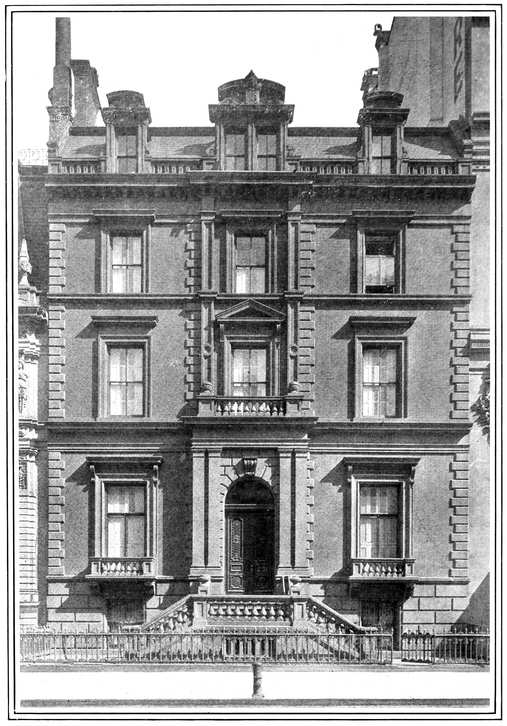
Former Residence of the Late William C. Schermerhorn
115
117
Church of the Transfiguration
It is difficult to realize the position held forty
years ago by the old Wallack’s Theater at
Broadway and Thirteenth Street. It was in a
way a city institution. The company remained nearly
the same for years, with occasional changes, and its
members were, one and all, accomplished in their profession.
The receipts of the theater were as regular as
those of a bank.
The elder Wallack, a well-bred Englishman, was a
finished actor of the old school. His son, Lester Wallack,
was an extraordinarily handsome man of the romantic
type, well suited for the more sentimental drama
of the day, although his wealth of curly black hair and
whiskers would violate our modern canons of taste. By
his father’s desire when a young man he became an officer
in the British army, but after serving two years
resigned and adopted the profession of the stage. His
wife was a sister of Millais, the artist.
George Holland was a short, thickset man with a
rather large head, who was seldom cast for a very prominent
part, but his humor and his evident geniality and
honesty made him a favorite with the public. Consequently
when the story of his funeral became public,
there was some indignation expressed.
118
It is fair to the Rev. Dr. Sabine, however, to say
that it is claimed that when approached by the parties
having charge of the funeral, he told them that the
Church of the Incarnation was undergoing repairs, that
the aisles were crowded with workmen and scaffolding,
and that it would prove an inconvenience to all parties
to hold the services in that church. The late Rev. Dr.
Houghton, rector of this parish for forty-nine years,
was a clergyman held in the highest esteem by the people
of this city.
121
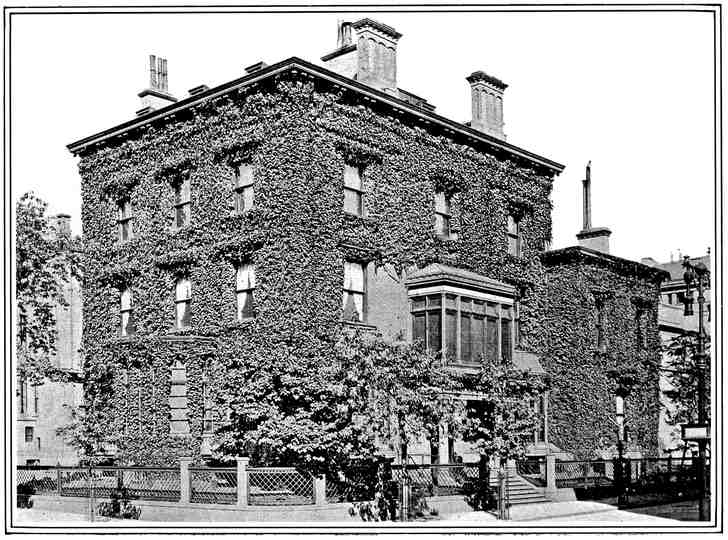
Residence of J. Pierpont Morgan
123
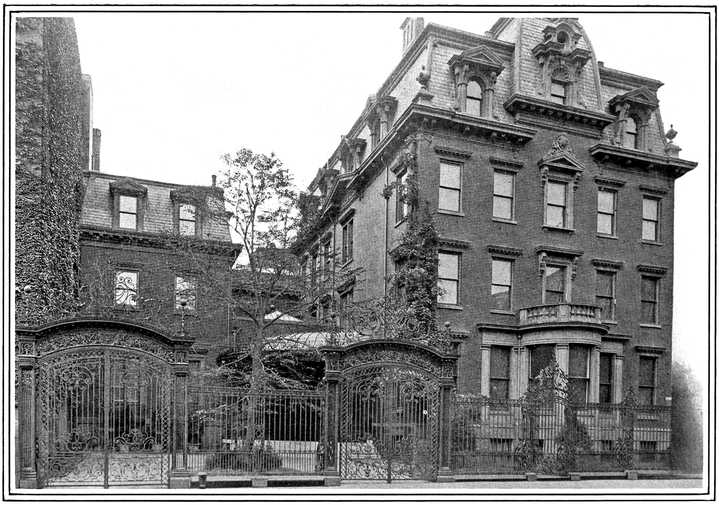
Former Residence of the Late Theodore A. Havemeyer
124
126
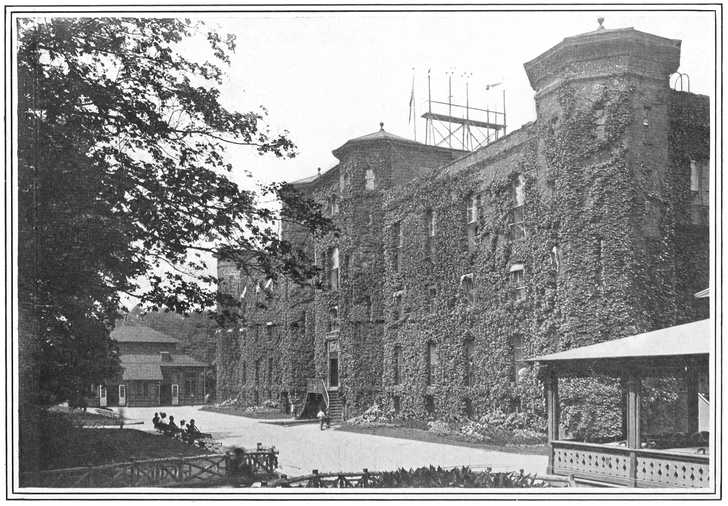
The Old Arsenal—Central Park
128
129
Claremont
The view of the Hudson, on a fine day, to a
person looking northward from Claremont is
one of the best on the river. Being on a high
point that juts out somewhat into the stream, the spectator
appreciates the river’s breadth. In former days
the site of Claremont was remarkable for its magnificent
trees, pine, oak and tulip, of extraordinary girth,
height and spread, but the building of the railroad
(which spoiled so many country seats) sounded its death
knell in respect to its being a place of residence with
appropriate surroundings. What is now known as
Claremont appears at an early period to have been
composed of two properties, the upper or northerly
one being called “Strawberry Hill,” or “Claremont,”
and the lower or southerly, one “Monte Alto.” Some
of the early deeds were not recorded and the writer
has not ascertained when or how the division was
made.
A tract of land including that on which the house
stands was conveyed in 1774 to Nicholas de Peyster,
and in August, 1776, was sold by him to George Pollock,
an Irish linen merchant.
Pollock endeavored to improve the place by clearing
and cultivation, as is shown by the statement in a letter130
mentioned below, in which he says: “I have long considered
those grounds as of my own creation, having
selected them when wild, and brought the place to its
present form.” He named the place “Strawberry
Hill.” After living there for some years and after the
loss of a child (said to have occurred by drowning) he
withdrew to England.
Almost everyone who has visited Grant’s Tomb remembers
the marble funereal monument in the form of
an urn inclosed within an iron railing near the top of
the hill. The inscription, much blurred by time, reads:
“Erected to the memory of an amiable child, St. Claire
Pollock, died 15th. July 1797 in the 5 year of his age.”
Then follow some lines of verse. In a letter written
from England by Mr. Pollock to Mrs. Gulian Verplanck,
who had become the owner of that or the adjoining
place, dated July 18, 1800, he writes: “There is
a small enclosure near your boundary fence within which
lie the remains of a favorite child, covered by a marble
monument.... The surrounding ground will fall into
the hands of I know not whom, whose prejudice or
better taste may remove the monument and lay the enclosure
open. You will confer a peculiar and interesting
favor upon me by allowing me to convey the enclosure
to you, so that you will consider it a part of your
own estate, keeping it however always enclosed and
sacred. There is a white marble funereal urn to place
on the monument which will not lessen its beauty. I
have long considered those grounds as of my own creation,131
having selected them when wild, and brought the
place to its present form. Having so long and so delightfully
resided there, I feel an interest in it that I
cannot get rid of by time.”32
In July, 1803, a tract of over thirty-one acres was
conveyed by John B. Prevost, former Recorder of the
city, to Joseph Alston, of South Carolina, planter.
Alston33 seems to have held the property about three
years and then to have sold it to John Marsden Pintard.
This deed conveys the tract known as “Monte Alto.”
In November, 1808, a release was recorded, executed by
Theodosia Burr Alston in favor of Michael Hogan,
gentleman, Hogan having bought Monte Alto from
Pintard.34
There is no record of any conveyance of Claremont,132
by Gulian Verplanck or his executors, to Hogan,35 but
a deed made by Robert Lenox, Jacob Stout, and John
Wells, trustees, to Michael Hogan, dated July 21, 1819,
reconveys to him all property not disposed of in the
execution of their trust, which is referred to as having133
been imposed by two previous deeds of assignment or
conveyance dated July 25, 1811. It is here that it is
generally thought a vagueness and uncertainty as to
the true owner exists. It was about this time that Claremont
was occupied by a rather mysterious individual, an
Englishman named Courtenay, who, it is said, in after
years, inherited the title of the Earl of Devon.
Mr. Haswell,36 in his “Reminiscences of an Octogenarian,”
says, page 25: “West of Broadway, between
Eleventh and Twelfth avenues and One Hundred and
Twenty-third Street, there was a large country residence
occupied by an Englishman, a Mr. Courtenay,
with but one man servant and a cook. He lived so
retired as never to be seen in company with anyone
outside of his household and very rarely in public.
“There was, as a consequence, many opinions given
as to the occasion of such exclusiveness. The one generally
and finally accepted was that he had been a gay
companion of royalty in his youth, and that his leaving
England was more the result of expediency with him
than choice.” Lossing’s37 account differs somewhat
from this. He says: “When the War of 1812 broke
out he (Courtenay) returned thither (to England)
leaving his furniture and plate, which were sold at auction....
Courtenay was a great lion in New York,
for he was a handsome bachelor, with title, fortune, and
reputation—a combination of excellencies calculated to134
captivate the heart desires of the opposite sex. Claremont
was the residence for a while of Joseph Bonaparte,
ex-King of Spain, when he first took refuge in the
United States, after the battle of Waterloo and the
downfall of the Napoleon dynasty. Here too Francis
James Jackson, the successor of Mr. Erskine, the British
Minister at Washington, at the opening of the War
of 1812, resided a short time.... He was politically
and socially unpopular, and presented a strong contrast
to the polished Courtenay.” Courtenay disappeared at
the time of the war between this country and Great
Britain, after having greatly embellished the place. It
has always been a tradition in the Post family (who
owned the property for nearly fifty years) that Courtenay
built the present house. In March, 1812, Hogan
joined with the above-named trustees in conveying the
property “commonly called Claremont” to Herman
Le Roy, William Bayard, and James McEvers, trustees.
By some it has been supposed that while the legal
title was in trustees, there may have been an unrecorded
declaration of trust, by which Courtenay became the
equitable owner. The grantees38 in the last-mentioned
deed first leased Claremont and several years later sold
it to Joel Post, February 12, 1821. Later, Mr. Post
(brother of the distinguished physician of the last century,
Dr. Wright Post, who also resided at Claremont)135
purchased the property adjoining on the south, Monte
Alto, and united the ownership of the two places, although
Monte Alto was for many years occupied as a
country seat by the McEvers family.39 In 1868 the
house and a portion of the place were acquired by the
city from the heirs of Mr. Post.
It seems to have been pretty well shown that the
battle of Harlem Heights was not fought in this locality.
It is only in recent years that Morningside Heights
have been spoken of as Harlem Heights. In conveying
Claremont it is described as in Bloomingdale and according
to the map (Mrs. Lamb’s “History of the City
of New York,” vol. II, p. 129) the westerly line of
Harlem excluded all Morningside Heights except a few
feet at the base of the high ground at Manhattanville.
The high ground was known as Vandewater Heights,
and if the battle had taken place there it would have
been known by that name. It is more probable that
most of the fighting (which was widespread) took place
at the base of the Point of Rocks, south of the Convent
of the Sacred Heart, and also along the high ground
to the west and north. Day’s Tavern stood a little to
the northeast of the Point of Rocks, and there Knowlton
and the Connecticut troops were stationed.
Major Lewis Morris, Jr., wrote to his father on
September 28th: “Monday morning an advanced party,
Colonel Knowlton’s regiment, was attacked on a
height a little to the southwest of Day’s Tavern.”
136
Morningside Heights would have been considerably
more than “a little” to the southwest of Day’s Tavern.
The detachment sent out before daylight under Knowlton
by General Washington was not his regiment but
a small body, probably a single company, and was sent
to make a diversion upon the enemy’s rear. It is probable
that they followed the river’s edge as far south as
Ninety-fourth Street, much below Claremont and Morningside
Heights. The actual battle did not begin until
late in the day. The resolution of Congress passed
October 17, 1776, was “Resolved, That General Lee
be directed to repair to the camp on the Heights of
Harlem with leave,” etc.
Washington had no camp on Morningside Heights.
His camp was on the high ground between the Point
of Rocks and the Harlem River.
Finally “nowhere on Manhattan Island, to my
knowledge, beyond the limit of the city, have there been
found the remains of so many English and Hessian
soldiers, as shown by buttons, cross-belt buckles, bayonets,
and portions of other arms, as have been excavated,
from time to time, in the neighborhood of Trinity
Cemetery. There could have been no fight at this
point unless it was at the battle of Harlem, while the
neighborhood about Columbia University, where it is
claimed the battle was fought, has been particularly
free from all such evidence.”40 Claremont is now a137
public restaurant.41 The adding of the huge inclosed
piazzas has produced an effect that is nondescript.
138
139
Hamilton Grange
Alexander Hamilton, although born
in another colony, was identified with the city
from boyhood and married into a New York
family.42 The genuine New Yorker seems always to
have had a certain regard for the memory of Hamilton,
ascribable perhaps to his untimely taking off, to a sentiment
of having been, as it were, robbed of the services
of a great man, and to the strong light thrown upon
the contrast between his traits and those of his distinguished
and brilliant antagonist.
He had faults, but they were very human ones, while
those of his adversary tended toward the incarnation of
selfishness. His career is probably more familiar to the
people than that of any of the other characters connected
with the State of New York during the Revolutionary
era. The site of the house (named after the
estate of his grandfather in Ayreshire, Scotland) was
chosen by him in order to be in proximity to the house
of his friend, Gouverneur Morris, at Morrisania. The
situation at that time, like that of the Jumel house,
commanded an extensive view of the Hudson and Harlem
rivers and Long Island Sound. It was then about
eight miles from town, so that it was his habit to drive140
in every day. It was not to this house that he was
brought after the disastrous event of July 11, 1804. His
friend William Bayard had received an intimation of
the proposed encounter, and was waiting when the boat
containing him reached the New York shore. Hamilton
was carried to his house and died there the next
day. His wife and children were with him. One daughter,
overcome by two such dreadful events in the family
within a short period, lost her reason.43 The whole city
was affected. Business was suspended. Indignation
was universal. Burr’s followers walked in the funeral
procession. Talleyrand said of Hamilton: “Je considére
Napoleon, Fox, et Hamilton comme lest trois plus
grande hommes de notre époque, et si je devais me
prononcer entre les trois, je donnerais sans hesiter la
première place a Hamilton.”
142
143
The Jumel House
This house was built in 1758 by Captain (afterwards
Colonel) Roger Morris of the British
army, who had been an aide of General Braddock.
Morris married a daughter of Colonel Philipse.
The Philipse estate embraced a great part of the present
Westchester and Putnam counties. The manor hall
erected about 1745 (the oldest part probably about
1682) now constitutes the City Hall of Yonkers.44 In
that house, on July 3, 1730, was born Mary Philipse,
and in the drawing-room on Sunday afternoon, January
15, 1758, she was married to Captain Morris by
the Rev. Henry Barclay, rector of Trinity, and his
assistant, Mr. Auchmuty.
A paper on “The Romance of the Hudson,” by
Benson J. Lossing, published in Harper’s Magazine
for April, 1876, gives the following account of the wedding:
“The leading families of the province and the
British forces in America had representatives there.
The marriage was solemnized under a crimson canopy144
emblazoned with the golden crest of the family....
The bridesmaids were Miss Barclay, Miss Van Cortlandt,
and Miss De Lancey. The groomsmen were Mr.
Heathcote, Captain Kennedy, and Mr. Watts. Acting
Governor De Lancey (son-in-law to Colonel Heathcote,
lord of the manor of Scarsdale) assisted at the
ceremony. The brothers of the bride ... gave away
the bride.... Her dowry in her own right was a
large domain, plate, jewelry, and money. A grand
feast followed the nuptial ceremony, and late on that
brilliant moonlit night most of the guests departed.
“While they were feasting a tall Indian, closely
wrapped in a scarlet blanket, appeared at the door of
the banquet hall, and with measured words said: ‘Your
possessions shall pass from you when the eagle shall
despoil the lion of his mane.’ He as suddenly disappeared....
The bride pondered the ominous words
for years ... and when, because they were royalists
in action, the magnificent domain of the Philipses was
confiscated by the Americans at the close of the Revolution,
the prophecy and its fulfillment were manifested.”45
While in New York in 1756 Washington stayed at
the house of his friend, Beverly Robinson, who had married
a sister of Miss Philipse, and there is no doubt
that her charms made a deep impression upon him, but
there is no evidence that she refused him.
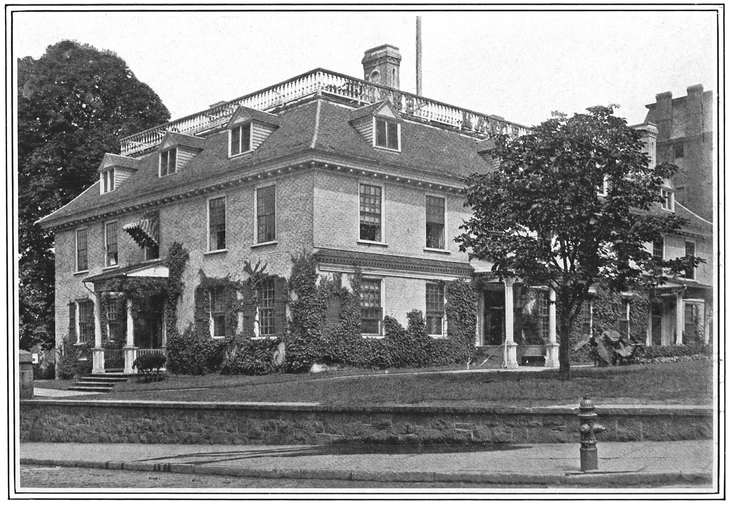
Manor Hall, Yonkers, 1682
After the Revolution Colonel Philipse withdrew to146
Chester, England, died there in 1785, and was buried
in Chester Cathedral, where there is a monument to
his memory. Some of his descendants are now living
in England, as well as descendants of Colonel and Mrs.
Morris. “A part of the Philipse estate was in possession
of Colonel Morris in right of his wife, and that
the whole interest should pass under the (confiscation)
act, Mrs. Morris was included in the attainder.”46 It
is believed that Mrs. Morris and her sisters were the
only women attainted of treason during the Revolution.
“In 1787 the Attorney General of England examined
the case and gave the opinion that the reversionary interest
was not included in the attainder,” and was recoverable,
and in the year 1809 Mrs. Morris’s son, Captain
Henry Gage Morris, of the royal navy, in behalf of
himself and his two sisters, sold their reversionary interest
to John Jacob Astor for twenty thousand pounds
sterling. In 1828 Mr. Astor made a compromise with
the State of New York by which he received for these
rights five hundred thousand dollars, with the understanding
that he should execute a deed with warranty148
against the claims of the Morris family, in order to quiet
the title of the numerous persons who had bought from
the commissioners of forfeitures. This he did.
In 1810 the property was bought by Stephen Jumel,
a wealthy French merchant. There he entertained
Louis Philippe, Lafayette, Joseph Bonaparte, Louis
Napoleon, and Henry Clay. After Jumel’s death it
came into the possession of his widow. Aaron Burr, in
his old age, married Madame Jumel. After he had
made away with a good deal of her money, she got rid
of him. He withdrew to other fields of action and died
somewhere on Staten Island.
During the Revolution Washington had his headquarters
here from September 16 to October 21, 1776,
and revisited it, accompanied by his cabinet, July, 1790.
The house is now in the control of the Department
of Parks and is shown to the public.
150
151
Gracie House—East River Park

Archibald Gracie, a native of Dumfries,
Scotland, of an old Scotch family, came to this
country about the time of the close of the
Revolutionary War and established himself as a merchant.
He became one of the largest if not the largest
ship owner in the country, his ships visiting, it is said,
every port in the world. He was a man of the highest
character. Oliver Wolcott said of him: “He was one
of the excellent of the earth, actively liberal, intelligent,
seeking and rejoicing in occasions to do good.” Washington
Irving wrote (January, 1813): “Their (the
Gracies’) country place was one of my strongholds last
summer. It is a charming, warm-hearted family and
the old gentleman has the soul of a prince.” Mr. Gracie
lost greatly as a result of the Berlin and Milan decrees,
over a million dollars, it is said. It is believed that
he was the largest holder of the celebrated “French
Claims,”47 which Congress with outrageous persistence
refused or neglected to pay for generations. He married
Esther, daughter of Samuel Rogers and Elizabeth152
Fitch, daughter of Thomas Fitch, Governor of Connecticut.
There was an old house at Gracie’s Point belonging
to Mrs. Prevoost, and this he either altered and enlarged
or else removed entirely and built the present structure,
but at what time it is not known. In the year 1805
Josiah Quincy was entertained there at dinner. He
describes enthusiastically the situation, overlooking the
then terribly turbulent waters of Hell Gate. He said:
“The shores of Long Island, full of cultivated prospects
and interspersed with elegant country seats, bound
the distant view. The mansion is elegant in the modern
style and the grounds laid out in taste with gardens.”48
Among the guests at that dinner were Oliver Wolcott,
Judge Pendleton, Hamilton’s second, and Dr. Hosack,
who later married Mrs. Coster.
William Gracie, the eldest son, married the beautiful
Miss Wolcott, daughter of Oliver Wolcott, Secretary
of the Treasury under Washington. A great reception
was given by Mr. and Mrs. Archibald Gracie
to the bride at this house. All the bridesmaids, groomsmen,
and a large company were assembled when the
bride died suddenly of heart disease. His daughter
Hester was married in the parlor of the house to William
Beach Lawrence, afterwards Governor of Rhode
Island. Another daughter married James Gore King,
the eminent banker, and another Charles King, afterwards
president of Columbia College, both being sons153
of Rufus King of Revolutionary fame. On one occasion
during the Napoleonic wars, a French vessel was
chased by an English frigate into the neutral harbor
of New York. The Englishman lay in the lower bay
ready to attack the Frenchman when he should return
through the Narrows. Being sure of his prize he was
off his guard. The French captain, taking a skillful
pilot, slipped up the East River, a feat believed impossible
for so large a vessel. In rounding Gracie’s
Point a sailor on a yardarm was swept from his perch
by the overhanging branches of a great elm that was
standing on the lawn as late as 1880. With wonderful
agility, the sailor seized the limbs and swinging from
one to another reached the trunk, down which he slid
to the ground. Charles King, calling to the Frenchman,
rushed to the other side of the Point, put him in
his boat and followed the man-of-war, although it had
then swung over to the other side of the river. By
skillful management he reached the vessel and the sailor
scrambled aboard. Anyone who remembers the waters
of Hell Gate before the rocky bottom was blown up
by the Government will admit that Mr. King did some
vigorous rowing. The man-of-war escaped by way of
the Sound, much to the chagrin of the English.
Many distinguished people were entertained in this
house. When Louis Philippe was here in exile he was
invited to dine with Mrs. Gracie. The carriage and
four were sent to town to bring the royal visitor, and
when he arrived the family were assembled to receive154
him. One of the little girls exclaimed aloud, “That is
not the king, he has no crown on his head,” at which
the guest laughed good-naturedly and said: “In these
days, kings are satisfied with wearing their heads without
crowns.” An early picture shows an ornamental
balustrade on the roof of the house and also on that
of the piazza, relieving the present rather bare appearance.
156
157
BOROUGH OF THE BRONX
The Gouverneur Morris House49
Gouverneur Morris was one of the most
interesting characters of the Revolutionary
era, interesting because he had an individuality
that distinguished him from the other worthies of
the time. Though crippled,50 his versatility and activity
of mind and body were very great. An orator of the
first rank, when but a few years past his majority he
swayed the Continental Congress with his views upon
matters of finance, a subject for which he had an especial
aptitude throughout his career. Resolving, when
a young man, to be the first lawyer in the land, he
became so. By reason of his connections, his education
and abilities, during his long stay abroad he associated
on intimate terms with a vast number of the most influential
personages living at the time. The unfortunate
King and Queen of France sought his advice and aid
in their troubles, as did Lafayette and many others.
158
His diary published in 1888 (now out of print),
written in Paris during the early days of the French
Revolution, although evidently for his own use, is
comparable with those other letters and memoirs of the
eighteenth century when writing of the sort was cultivated
as a fine art.
His father’s will states: “It is my desire that my
son, Gouverneur Morris, may have the best education
that is to be had in England or America.” Great pains
were taken that this should be carried out, so that he
should be fitted for any career that might open to him.51
He was a member of the Provincial Congress of New
York, in 1775, “serving on the various committees with
such well-balanced judgment as to command the respect
of men of twice his age and experience.” Twice elected
to the Continental Congress, he was a chairman of three
committees for carrying on the war,52 wrote continually
on all subjects, especially that of finance, and
at the same time practiced law, doing all this before
he was twenty-eight years of age. After five years
of devotion to public affairs, he became a citizen of
Philadelphia and settled down to the practice of his
profession.
In 1787, as a delegate from Pennsylvania, he took
his seat in the convention which met to frame the Federal
Constitution. He had been connected in certain
financial ventures with William Constable of New York,159
which had been eminently successful, and in November,
1788, led partly by matters relating to these and partly
by the desire to travel, he decided to visit France. His
life on the other side became so crowded with interesting
and important events that this visit was prolonged far
beyond his intention. It was ten years before he returned.
He was furnished by Washington with letters
to persons in England, France, and Holland. He was
present at the assembling of the States-General at Versailles,
which has been called the “first day of the French
Revolution,” and from that time on was au fait with
all the important events of that exciting period. At
times he was in almost daily communication with the
Duchess of Orleans, Madame de Staël, Talleyrand, and
hosts of others equally important.
He was soon recognized as applying a clear brain
to the solution of any important question submitted to
him, and we find him writing a memoir for the guidance
of the king and the draught of a speech to be delivered
before the National Assembly. The Monciel scheme,
usually mentioned in the biographies of Morris, was a
well-conceived plan to get the king out of Paris. Monciel,
one of the ministry, consulted Morris as to the
details of the plan, and the king deposited with him
his papers and the sum of seven hundred and forty-eight
thousand francs. Everything was discreetly arranged
and success nearly assured when, on the morning
fixed for the king’s departure, he changed his mind and
refused to budge. Later the money was nearly all withdrawn,160
leaving a small balance in Morris’s hands which
he returned to the Duchess d’Angoulême.53
In 1789 Washington had written him a letter requesting
him to visit England and endeavor to facilitate
the carrying out of the terms of the treaty between the
two countries, but the English governing class at that
day had no desire to facilitate anything in which this
country was interested. He had many interviews with
Leeds and Pitt, but was always met with a policy of
vagueness, postponement, and unlimited delay, so that
he accomplished little. It was partly on this account
that when Washington nominated him as Minister to
France in 1791, the nomination was opposed. His views
also regarding the condition of France were well known.
He did not deem that country fitted for a radical change
of government nor for the development of the wild
theories of government that were there rampant.54 The161
sanity of these views was proved by subsequent events,
but many senators did not regard him as suitable to
represent this republic. He was, however, confirmed by
a moderate majority. He continued to be Minister until
Genet was recalled at the request of Washington.
Then France requested his recall on the ground of
“reciprocity.”
Monroe arrived in Paris in August, 1794. Morris
intended to return, but changed his plans and decided
to spend another year in Europe visiting some of the
principal courts and traveling55 through various countries,
but events were so interesting and produced so
much stir and excitement that it was fully four years
before he returned.
While in England he was presented at court, November
25, 1795.56 Finally in October, 1798, he sent
his steward to New York with all his “books, liquors,162
linens, furniture, plate and carriages,” and soon after
followed himself.
On his mother’s death in 1786, the estate of Morrisania
devolved on his eldest brother, Staats Morris;
but he, having no intention of living in this country,
willingly sold it to him, including his father’s house, in
which he was born. The house he found in poor condition,
and at once set about the task of repairing and
adding to it. After its restoration, he settled there, and
for the rest of his life the house became the scene of a
continuous hospitality, not only to the most eminent
Americans of the day, but to nearly every foreigner of
distinction that came to this country.
He was elected a United States Senator and was
always interested in public affairs. He is said to have
been the originator of the Erie Canal. In December,
1809, he married Miss Randolph of Virginia. In May,
1804, he was present at the deathbed of his friend,
Alexander Hamilton, and later delivered the funeral
oration.
Sparks57 says: “The plan of his house conformed163
to a French model, and though spacious and well contrived
was suited rather for convenience and perhaps
splendor within than for a show of architectural magnificence
without.” To a friend he wrote: “I have a
terrace roof of one hundred and thirty feet long,58 to
which I go out by a side or rather back door, and from
which I enjoy one of the finest prospects while breathing
the most salubrious air in the world.” The parquet
floors of all the rooms were brought from France. The
library, wainscoted and ceiled with Dutch cherry panels,
also imported, was in the early days hung with white
and gold tapestry. The room contained the mahogany
desk, still preserved, trimmed with brass (said to have
been a present from one of the royal family), at which
he carried on his correspondence with so many distinguished
personages, correspondence often relating
to loans of money to the Duchess of Orleans,
Madame de Lafayette, Louis Philippe, and hundreds
of others.
The reception room, twenty-two by thirty feet and
fourteen feet high, was also a paneled room with mirrors
set in the wall in the French style. It contained
a number of pieces of gilt furniture, originally covered
with white silk embroidered in gold, with designs from
Boucher which he had brought with him from France.
The dining room of peculiar shape (a half octagon)
was paneled in dark wood and contained a curious reminder
of life during Revolutionary days, a dumbwaiter164
placed near each guest so that servants need not be
admitted to overhear the conversation.59
Morris died on November 6, 1816, in the room in
which he was born. Almost the last letter he wrote was
to plead with the Federal Party to “forget party and
think of our country. That country embraces both parties.
We must endeavor therefore to save and benefit
both.” What statesman to-day would put forth such
a sentiment?60
166
167
Van Cortlandt House
The property on which the house stands belonged
in the seventeenth century to the Hon. Frederick
Philipse and was sold by him in the year
1699 to his son-in-law, Jacobus Van Cortlandt, who had
married his daughter Eva. The house was built in 1748
by Frederick Van Cortlandt, only son of Jacobus, who
married Frances Jay, daughter of Augustus Jay, the
Huguenot. His will, dated October 2, 1749, states:
“Whereas I am now finishing a large stone dwelling
house on the plantation in which I now live, which with
the same plantation will, by virtue of my deceased father’s
will, devolve, after my decease, upon my eldest
son, James,” etc.61
During the Revolutionary War the neighborhood
was constantly the scene of conflicts. Washington visited
the house in 1781, and on the hill to the north
disposed part of his army, which lighted camp fires while
he was quietly withdrawing the rest of his troops to
join Lafayette before Yorktown. There was a bloody
engagement near the house on August 31, 1778, between
the British, under Lieutenant-Colonel Simcoe,
and a body of Stockbridge Indians. The Indians
fought with great bravery and desperation, dragging168
the cavalrymen from their horses, but were ultimately
dispersed, their chief being killed.62
Washington slept here the night before the evacuation
of the city by the British, November 25, 1785. The
estate has been bought by the city and is now known
as Van Cortlandt Park. It contains 1,070 acres. There
is a lake covering sixty acres and a parade ground for
the National Guard on a level meadow of 120 acres.
The house is used as a museum and is crowded with
interesting relics.
170
171
BOROUGH OF QUEENS
The Bowne House—Flushing

This house was built in 1661 by John Bowne,
a native of Matlock, Derbyshire, England, in
whose church he was baptized in the year 1627.
About 1672 George Fox, founder of the sect of Quakers
or Friends, visited Flushing and held meetings there.
Bowne’s wife63 frequently attended the meetings, and
after a time joined the sect. As a result of this, Quakers
were often entertained at the house. Governor Stuyvesant
had Bowne arrested for “harboring Quakers,” and
he was thrown into jail. Prior to this Henry Townsend,
of Oyster Bay, had been subjected to the same
treatment. Bowne, being a man of considerable independence,
remained obdurate. He was then banished
to Holland. He presented his case to the Dutch West
India Company in such a manner that he was returned
in a special ship with the following rebuke to the Governor
and Councils of the New Netherlands, 1663: “We
finally did see from your last letter you had exiled and
transported hither a certain Quaker named John Bowne,
and although it is our cordial desire that similar and
other sectarians might not be found there, yet, as the
contrary seems to be the fact, we doubt very much if172
vigorous proceedings against them ought not to be discontinued,
except you intend to check and destroy your
population, which, however, in the youth of your existence
ought rather to be encouraged by all possible
means, wherefore it is our opinion that some connivance
would be useful that the conscience of men, at least,
ought ever to remain free and unshackled.
“Let everyone be unmolested as long as he is modest,
as long as his conduct, in a political sense, is irreproachable,
as long as he does not disturb others or
oppose the Government.” Signed, “The Directors of
the West India Company, Amsterdam Department.”
The house has always remained in the possession of
the descendants of the first owner. House and furniture
are in a good state of preservation; they are in
charge of a caretaker and shown to visitors.
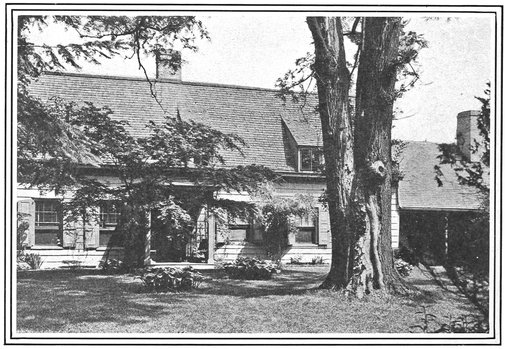
174
175
BOROUGH OF RICHMOND
The Billop House
For more than a century Staten Island was practically
in the control of the Billop family.
The Billops for several generations had led
active and valiant careers in the service of the sovereign.
One, James, in the sixteenth century, is said to
have won the friendship of Queen Elizabeth by risking
his own life in order to save hers. They had favors
also from the Stuart line.
Christopher, born in 1638, received a naval training
by command of Charles I. He was commissioned captain
and made important and adventurous voyages, in
one of which he was wounded, captured by Turkish
pirates and abandoned, to be later rescued by a passing
ship. In 1667, whether by order of Charles II or on
his own account it is not known, he sailed from England
in his vessel, the Bentley, and came cruising in
the waters of the New Netherlands. The tradition is
that the Duke of York, to determine the ownership of
the islands in the bay, decided that any island that could
be circumnavigated in twenty-four hours belonged to
the province of New York, and Billop, having proved
that Staten Island was so included by sailing around it176
in the required time, was presented with 1,163 acres in
the southern part of the island. On this tract he built
in 1668 the stone house here presented. The stones and
lumber were obtained in the vicinity, but the cement
was brought from England and the bricks from Belgium.
In the early records his name appears as showing
that he had several public positions, but apart from that
little is known about him except that he held a military
command and had a controversy with Governor Andros
to his disadvantage at first, but later he succeeded in
having the governor recalled to England.
In the year 1700 he sailed for England in the
Bentley, but was never heard of again. By some
writers it is thought that he was ordered back, inasmuch
as a pension was assigned to his widow by the
king. Captain Billop married a Miss Farmer, sister
of a Supreme Court judge in the neighboring province
of New Jersey. They had one child, a daughter, who
married her cousin, Thomas Farmer, and he, succeeding
to the manor of Bentley, changed his name to
Billop. Both died young and their tombstones are to
be seen at the house to-day. Christopher Billop, their
only son, born 1735, was a prominent man in public
affairs throughout his life. In the Revolution he was
intensely loyal to the crown, and became a colonel in
the British army. Twice he was captured. The New
Jersey colonists were especially bitter toward him, and
once by keeping men stationed in the steeple of St. Peter’s177
Church at Perth Amboy they observed him going
into his house. Immediately they took boats, crossed
the river and made him prisoner. By order of Elisha
Boudinot (Com. Pris. of New Jersey) he was thrown
into jail at Burlington, hands and feet chained to the
floor and fed only on bread and water. Here his companion
in captivity was Lieutenant-Colonel Simcoe of
the Queen’s Rangers, probably the same Simcoe who
was in the engagement near the Van Cortlandt house.
Billop was exchanged for a captain who had been on
the prison ship. The second time he was taken he was
released by Washington at the solicitation of Lord
Howe, commander in chief of the British forces.
After the battle of Long Island, Howe thought it
an opportune time to offer favorable terms to the colonists
if they were willing to lay down their arms. Accordingly
he dispatched General Sullivan (then a prisoner)
to Congress requesting them to send a committee
to negotiate. This committee, composed of Benjamin
Franklin, Edward Rutledge, and John Adams, met
Howe at the Billop house. “Along the sloping lawn
in front of the house, long lines of troops that formed
the very flower of the British army were drawn up between
which the distinguished commander escorted his
no less distinguished guests.”64 The conference was held
in the northwest room on the ground floor. It resulted
in nothing, the colonists refusing to accede to any terms
not involving their independence. About 1783–84 Billop178
withdrew to New Brunswick, and joined that army
of estimable persons who, despoiled of their possessions,
were driven from the land for their loyalty to their
king. There for years he held prominent offices in the
Assembly and in the Council and died at St. John,
March 23, 1827, at the age of ninety-two. At his
funeral the highest honors of the town were paid to
his memory.
Billop was evidently a complete type of the country
gentleman and tory squire. According to Mr. Morris,
in his “Memorial History of Staten Island,” the following
description of him was given by a friend:
“Christopher Billop was a very tall, soldierly looking
man in his prime. He was exceedingly proud and his
pride led him at times to the verge of haughtiness. Yet
he was kind-hearted, not only to those he considered
his equals, but to his slaves as well as to the poor people
of the island. No one went from his door at the old
manor hungry. It was his custom to gather the people
of the island once a year on the lawn in front of his
house and hold a ‘harvest home.’... Passionately
fond of horses, his stable was filled with the finest bred
animals in the land. He was a magnificent rider and
was very fond of the saddle. He was an expert shot
with the pistol, which once saved his life when he was
attacked by robbers. Christopher Billop was not a man
to take advice unless it instantly met with his favor....
Lifelong friends pleaded with him to join the cause
of independence at the commencement of the Revolution,179
but he chose to follow the fortunes of royalty. He
was a good citizen, a noble man!”
Before the Revolution the house was noted for its
hospitality and gayety in the Colonial society of the
day. The owner entertained lavishly and at the time
of the war he received there Generals Howe, Clinton,
Knyphausen, Cleveland, Cornwallis, Burgoyne, and
many others. The interior of the house is extremely
plain. Presumably in the year 1668 the house decorator
had not made his appearance. The walls are three
feet thick and the woodwork as sound as on the day
it was built. There is of course a ghost room, with
“that spot on the floor that cannot be washed out”
where murder is said to have been done. Below there
is a dungeon with massive iron gate, and the marks are
still visible where prisoners, American and then British,
tried to cut their way out through the three-foot wall
and arched ceiling.65 It is said there was an underground
passage leading to the river.
In the basement Fenimore Cooper laid one of the
scenes in his novel of the “Water Witch.”
The grounds, once laid out with parklike lawns and
flower beds, are now in the last stages of dilapidation.
Transcriber’s Notes
Punctuation, hyphenation, and spelling were made
consistent when a predominant preference was found
in the original book; otherwise they were not changed.
Simple typographical errors were corrected; unbalanced
quotation marks were remedied when the change was
obvious, and otherwise left unbalanced.
Inconsistent use of small-caps in the “Subjects”
(Table of Contents) has been retained here.
Misspelled French words were not corrected.
Photographs of the buildings usually are just above the chapters
referring to them, and the Table of Subjects refers to the chapters,
not to the photographs. However, the hyperlinks in the Table of Subjects lead
to the photographs.
*** END OF THE PROJECT GUTENBERG EBOOK 60342 ***












